![]()
![]()
![]()
Use LEFT and RIGHT arrow keys to navigate between flashcards;
Use UP and DOWN arrow keys to flip the card;
H to show hint;
A reads text to speech;
582 Cards in this Set
- Front
- Back
- 3rd side (hint)
|
middle-aged pt c/ anemia, splenomegaly, constitutional sx, WBC > 100,000
low leukocyte alk phos high LDH, uric acid, B12 Tx |
CML
c-abl = Tyr kinase t(9:22) translocation is ass'd c/ CML > ALL Tx: Chronic = 1st stage: Imatinib = Gleevac = bcr-abl Tyr kinase inhibitor. allogenic stem cell tx for younger pt Blast = 3rd staqe: same as acute leukemia or c/ dasatinib + hematopoeitic stem cell tx |
|
|
|
Pt > 50 y/o c/ lymphoma most likely has _
Dx is made by _ Tx is based on _ Tx options _ Bcl-2 gene inhibits apoptosis t(14;18) => Bcl-2 activation "small cleaved cell" lymphoma CD10 B cells |
Follicular = #1 NH Lymphoma
NHL is 5x more common than HL Dx by excisional LBN bx Tx based on histopath classification: Symptomatic => radiation + CHOP (Cyclophosphamide = Cytoxan, Adriamyin, Vincristine, Predisone) High, grade aggressive dz => aggessive, curative tx Low-grade indolent dz => palliative |
|
|
|
Rb
Gene is ass'd c/ 3 cancer risks... |
Tumor supressor
13q14 Retinoblastoma, osteosarcoma, breast carcinoma |
|
|
|
p53 (3 cancers, 1 genetic syn)
|
tumor supressor on 17q13.1
BBCD: breast, bronchial, colon Li-fraumeni syn = autosomal D |
|
|
|
Young adult c/:
cervical adenopathy pruritus hepatosplenomegaly 1-2 wks of fever alternating c/ 1-2 afebrile weeks +/- EtOH-induced pain in nodes Dz Dx by _ (look for _) Tx based on _ |
Nodular sclerosing Hodgkin's lymphoma
#1 HL. Excisional LN bx => Reed-Sternberg cells (giant B cells c/ bilobar nuclei, red nucleoli) Tx based on stage: # nodes, systemic B sx, whether dz crosses diaphragm Tx: local radiation ABVD: Adriamycin, Bleomycin, Vinblastine, Decarbazine' MOPP: Mechlorethamine, Vincristine, Procarbazine, Prednisone 5-yr survival: Stage 1,2 (1 side of diaphragm) 90%, Stage 3 85%, Stage 4 65% |
|
|
|
Common risk factor for AML, NHL, breast cancer, thyroid cancer
|
Chemotherapy, Radiation -> secondary neoplasms
|
|
|
|
What diseases?
Paternal 15q deletion => infantile hypotony, obesity, MR Maternal 15q deletion => happy smile, wide gait, epilepsy |
Paternal: Prader willi = infantile hypotony, obesity, MR
Maternal: angelMan = happy smile, wide gait, epilepsy |
|
|
|
Elderly pt c/:
lethargy, wt loss Raynaud's phenomenon Mental status changes Sensorimotor peripheral neuropathy Blurred vision BM bx => PAS (+) deposits around nucleus Dz Major precursor _ Dx _ (look for _) |
Waldenstrom's macroglobulinemia
Chronic, indolent malignancy in elderly pts clonal B cells -> high IgM -> hyperviscosity, abnl coagulation, cryoglobulinemia -> Raynaud's, neuro probs cold agglutinin dz-> autoimmune hemolytic anemia Skin, GI, kidneys, lungs Amyloidosis MGUS = monoclonal gammopathy of undetermined significance = major precursor BM bx => Dutcher bodies = PAS (+) deposits |
|
|
|
Ewing's sarcoma
midshaft of long bones: femur > pelvis > fibula > humerus fever, anorexia, fatigue => mets neuroectodermal origin t(11;22) Tx: local excision + chemo, rad |
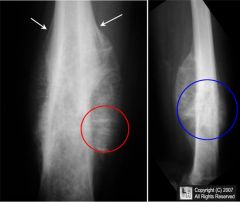
white male teenager
pain + swelling in midshaft of femur fever, anorexia, fatigue leukocytosis elevated ESR lytic bone lesions on X-ray Disease Tx |
|
|
|
anemia, thrombocytopenia, frequent infections
elevated WBC count, esp. myeloblasts FAB types M0-M7 what disease? what therapy? |
AML
t(15;17) Tx: primarily chemo allopurinol premedication to avoid tumor lysis syn Tx for leukostasis syn = hydroxyurea +/ - leukapheresis M3 type (acute promyelocytic) responsive to all-trans retinoic acid Poor prognosis: age >60, CD34+ or MDR1+ phenotype, elevated LDH, trisomy 8, mutated xsome 5 or 7, t(6:9), FLT3 mutatoin, FAB M7 (acute megakaryoctic) |
|
|
|
Acanthosis nigricans is ass'd c/ what neoplasm?
|
Visceral malignancy: SLUT
Stomach Lung Uterus Titties acanthosis nigricans = hyperpigmentation + epidermal thickening |
|
|
|
Intrinsic coag pathway:
Measured by _ Initiated by event of _ Inhibited by drug _ |
Intrinsic coag pathway:
Measured by PTT Initiated by exposure of collagen 2/2 vascular trauma Inhibited by heparin: increases PTT decreases fibrinogen safe in pregnancy |
|
|
|
extrinsic coag pathway:
measured by _ initiated by _ inhibited by drug _ involves coag factors _ |
extrinsic coag pathway:
measured by PT initiated by endothelium-produced tissue factor inhibited by warfarin (warfarin inhibits factor 7) factor 3 activates factor 7 to 7a. 7a or 8a (intrinsic) activate factor 10. involves coag factors _ |
|
|
|
50% rate of bilateral renal cell carcinoma
hemangioblastomas of retina, cerebellum, medulla |
von Hipple Lindau
Deletion on 3p associated with cancer _ =>50% rate of bilateral renal cell carcinoma also hemangioblastomas of retina, cerebellum, medulla VHL gene = tumor supressor |
|
|
|
pt c/ high PT, PTT, thrombin time, FDPs + D-dimers.
Low factor VIII, platelets Generalized bleeding, ecchymoses, petechiae, +/- acral cyanosis Dz Tx |
acute DIC
(unlike in severe liver dz, factor VIII is depressed) Fibrin deposits in small vessels -> thrombosis, organ damage Depletion of clotting factors, platelets -> bleeding diathesis Ass'd c/ OB complications, sepsis, neoplasms, acute promyelocytic leukemia, pancreatitis, intravascular hemolysis, aortic aneurym, massive tissue injury/trauma, drug rxns, acidosis, ARDS Tx: May need transfusion, shock mgmt Platelets in hemorrhage c/ plt <20,000 |
|
|
|
How is CF diagnosed?
|
Sweat chloride test:
>60 mEq/L for pts <20y/o >80 mEq/L for adults |
|
|
|
4 causes of microcytic anemia
|
2/2 maturation disorder
TICS: Thalassemia Iron deficiency Chronic dz Sideroblastic anemia |
|
|
|
Baby c/ transposition of the great vessels (cyanosis, critical illness right after birth) may have what genetic syndrome?
|
DiGeorge's: "CATCH-22"
Cardiac defects Abnl facies Thymic hypoplasia => T cell don't mature Cleft palate Hypocalcemia xsome 22 microdeletion (2 main RFs for transpositon are mother c/ DM and DiGeorge) |
congenital heart defect present
|
|
|
#1 cyanotic congenital heart disease in children is _
It consists of _ Initial tx is _ RFs are _ |
Tetrology of Fallot => PROVe
Pulm stenosis RVH Overriding aorta VSD (cyanosis 2/2 L->R shunt) Inital tx = PGE1 RFs: PKU, CATCH-22 syndrome = DiGeorge |
|
|
|
Adult c/ hemangioblastoma in the posterior fossa
R/o sydrome _ to make sure pt is not at elevated risk of _ |
von Hipple Lindau hemangioblastomas of retina, cerebellum, medulla
Cysts in other organs 50% rate of bilateral renal cell carcinoma |
|
|
|
Baby has:
Microcephaly Cleft lip/palate Polydactyly Cardiac dextroposition, septal defects |
Patau = Trisomy 13
|
|
|
|
Baby has:
IUGR, MR, FTT Short sternum, small pelvis Rocker-bottom feet Cardiac, renal, intestinal defects |
Edwards = Trisomy 18
Death <1 yr 4x more common than Trisomy 13 |
|
|
|
cafe-au-lait spots
pigmented lesions on the iris peripheral nerve tumors Axillary/inguinal freckles kyphoscoliosis Disease Dx done via _ Increased risk of _ |
Von Recklinghausen = Neurofibromatosis 1 = 90% of NF
AD, xsome 17 1.Café au lait spots 2. Lisch nodules (pigmented iris hamartomas) 3. Multiple neurofibromas 4. Axillary/inguinal freckles RF for OPTIC GLIOMA, meningiomas, pheochromocytoma, bone cysts, Wilms', leukemia Dx: MRI of brain, brainstem, spine |
|
|
|
Bilateral acoustic neuromas
Disease Increased risk of _ |
Neurofibromatosis type 2
Mutation in NF2 tumor-supressor AD RF for acousic schwannoma Risk of meningiomas, pheochromocytomas 10% of NF cases |
|
|
|
Medullary carcinoma of thyroid
Adrenal hyperplasia/ pheochromocytoma Parathyroid hyperplasia |
MEN 2A = Sipple's
like MEN 1: Parathyroid hyperplasia Like MEN 2B: Medullary carcinoma of thyroid Adrenal hyperplasia/ pheochromocytoma |
|
|
|
In children, 2/3 of brain tumors are located _
3 most common types |
Children: 2/3 of brain tumors are infratentorial (posterior fossa: cerebellum, brainstem)
cerebellar astrocytoma > medulloblastoma > ependymoma |
|
|
|
preschooler c/:
flank mass contains calcifications on imaging (+) HVA in urine |
neuroblastoma
Malignant #1 adrenal medulla tumor in kids Catecholamine secreting => HVA in urine Rarely regress spontaneously |
|
|
|
child c/ calcified tumor in/around sella turcica
|
Craniopharyngioma
= remanant of Rathke's pouch |
|
|
|
P-ANCA (+)
Asthma Vasculitis Eosinophilia |
Churg-Strauss
|
|
|
|
Hypogonadism
Cancer (hepatocellular) Cirrhosis (micronodular) Cardiomyopathy Diabetes mellitus Arthropathy Disease Tx |
Hemochromatosis
AR (or due to chronic transfusions) Tx = deferoxamine, phlebotomy "HaemoChromatosis Can Cause Deposits Anywhere": Hypogonadism Cancer (hepatocellular) Cirrhosis (micronodular) Cardiomyopathy Diabetes mellitus Arthropathy |
|
|
|
HLA B27 (3 diseases)
|
PAIR:
Psoriasis Anylosing Spondylitis IBD = Ulcerative Colitis Reiter's for MHC1 |
|
|
|
Deep tendon reflexes:
S1,2 L3,4 C5,6 C7,8 |
S1,2 achilles (tibia = S1,2,3,L4,5)
L3,4 knee (femoral = L2,3,4) C5,6 biceps, supinator (MC C5,6,7) C7,8 triceps (radial = C 5,6,7,8,T1) |
|
|
|
low platelet count
microangiopathic hemolytic anemia neuro changes: delirium, seizure, stroke impaired renal fx fever schistocytes on peripheral smear normal coag factors, PT, PTT Disease Mechanism Tx |
TTP
2/2 platelet microthrombi -> ischemia, hemolysis low platelet count microangiopathic hemolytic anemia neuro changes: delirium, seizure, stroke impaired renal fx fever |
|
|
|
Innervation of thigh: obturator, femoral, sciatic nerves
|
MAP OF sciatic
Medial compartment => Obturator Anterior compartment => Femoral Posterior compartment => Sciatic |
|
|
|
Hyperacute rejection:
mediated by _ time course _ |
Ab-mediated
Due to pre-formed anti-donor Ab's w/in minutes of transplant |
|
|
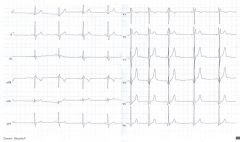
What is wrong with this EKG?
suggests electrolyte imbalance.... |

U wave (esp. in V3) = repolarization of papillary muscles or Purkinje fibers. Hypokalemia > hypercalcemia, thyrotoxicosis, digitalis, epinephrine, Class 1A and 3 antiarrhythmics, congenital long QT syn., intracranial hemorrhage.
|
|
|
|
AIDS pt or young child c/ rash:
tiny waxy papules c/ central umbilication Adult: genitalia, perineum Child + AIDS pts: trunk, face, extremities Dz Dx Organism Tx |
Molloscum contagiosum
Poxvirus Dx: Giema or Wright's stain => inclusion/molloscum bodies Tx: Dessication, currtage, imiquimod, trichloroacetic acid Resolve spontaneously over weeks-years Left untreated in children |
|
|
|
Organ recipient c/
maculopapular rash jaundice hepatosplenomegaly diarrhea |
Graft vs. Host dz
Mediated by grafted immunocompetent T cells. |
|
|
|
Musculocutaneous innervates 3 muscles in upper arm...
|
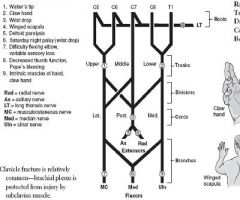
BBC:
Biceps brachii Brachialis Coracobrachialis |
|
|
|
Hgb degradation products in RBCs
G6PD deficiency: hemolysis c/ oxidative stress = viral infection, fava beans, sulfa drugs, nitrofurantoin, quinine |
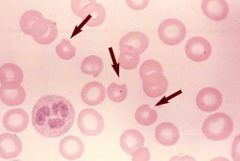
Heinz bodies
|
|
|
|
Alpha Thalassemia: SE Asia
Βeta Thalassemia: Mediterranean + US |
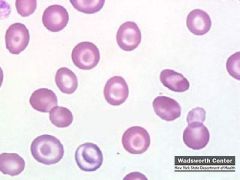
Hypochromic rbs, target cells
|
|
|
|
Nuclear fragments
Asplenia |
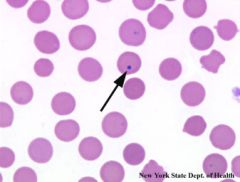
Howell-Jolly bodies
|
|
|
|
Encapsulated microbes - name 7
(remember mnemonic) |
"Some Nasty Killers Have Some Capsule Protection":
Streptococcus pneumoniae Neisseria meningitidis Klebsiella pnemoniae Haemophilus influenzae Salmonella typhi Cryptococcus neoformans Pseudomanas aeruginosa |
"Some Nasty Killers Have Some Capsule Protection"
|
|
|
Auer rods
|
In myeloblasts. AML
|
|
|
|
Reed-Stenberg cells
|
Hodgkin;s. Binucletaed, prominent nucleoli, clear parachromatin.
|
|
|
|
Waldenstrom's macroglobulinemia. IgM, Malignant
|
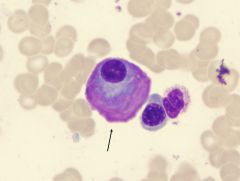
Flame cells, Hyperviscosity
|
|
|
|
4 anterior mediastinal masses
|
4 T's:
Teratoma Thymoma Testicular-type T-cell / Hodgkin's lymphoma |
|
|
|
Helmet cells
|
Fragmented RBCs
Thrombotic thrombocytic purpura |
|
|
|
Hypersegmented neutrophils
|
B12/Folate deficiency
|
|
|
|
>40 y/o c/:
Bence Jones protein (IgG 50%, IgA 25%) Russell bodies = Ig inclusions in plasma cells osteolytic lesions Hypercalcemia |
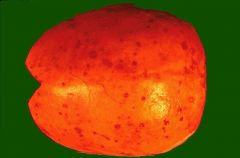
Multiple myeloma
|
|
|
|
50% of ovarian tumors are type _
Psammoma bodies on histopath |
serous cystadenocarcinoma
maignant and frequently bilateral |
|
|
|
Lewy bodies
|
Intracytoplasmic eosinophilic bodies
Parkinson's |
|
|
|
Kayser-Fleisher rings
|
Wilson's dz
|
|
|
|
Negri bodies
|
Eosinophilic
Rabies |
|
|
|
Painless transient papule/shallow anogenital ulcer ->
painful inflamm of inguinal nodes c/ constitutional sx -> anal pruritus + discharge, proctocolitis, stricture, rectovaginal fistula, elephantiasis Inclusion stain c/ periodic acid-Schiff |
Lymphogranuloma venereum (L-serotype Chlamydia)
periodic acid-Schiff stains glycogen doxycycline 100 mg BID x 21 days |
|
|
|
Intranuclear inclusions (virus)
|
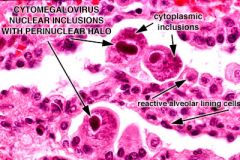
CMV
|
|
|
|
asbestosis
Causes of pulmonary fibrosis = BREAST SCAR: · Upper lobe: Beryliosis Radiation Extrinsic allergic alveolitis Ankylosing spondylitis Sarcoidosis TB · Lower lobe: Systemic sclerosis Cryptogenic fibrosing alveolitis Asbestosis Radiation |
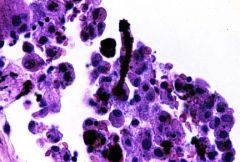
Ferruginous bodies
|
|
|
|
Psammoma bodies:
associated with 4 tumor types… |
Psammoma body = laminated, concentric, consist of calcium
PSaMMoma: Papillary thyroid Serous ovarian (papillary serous cystadenoma) Meningioma Malignant mesothelioma |
|
|
|
Eosinophilia is suggestive of 5 things…
|

"NAACP"
Neoplasm Allergies Asthma Collagen vascular disease Parasites |
|
|
|
Ovarian mass causing feminization, precocious puberty
Call-Exner bodies |
Granulosa ovarian tumor (estrogen-secreting)
|
|
|
|
Testicular mass causing precocious puberty, gynecomastia
Reinke crystals |
Leydig testicular tumor
secrete androgens (seminoma = #1 testicular tumor) |
|
|
|
Warm Ab's = IgG
|
Drugs
Malignancies SLE |
|
|
|
Cold Ab's = IgM
4 possible diseases... |
Mycoplasma pneumonia
Mononucleosis Hodgkin's lymphoma Multiple myeloma |
|
|
|
Direct coomb's
mix pt's _ c/ _ |
detects Ab's bound to cells
mix pt's RBCs c/ anti-IgG Detects sensitized erythrocytes |
|
|
|
Indirect coomb's
|
detects free Ab's
mix pt's plasma c/ normal RBCs |
|
|
|
Aplastic anemia is caused by:
|
Viruses:
Toxins: Drugs: alkylating agents, Chloramphenicol |
|
|
|
Side effect common to these:
Alkylating agents Chloramphenicol Chlorpromazine Sulfonamides Phenylbutazone |
Neutropenia
|
|
|
|
Prolonged PT:
Pathway _ Diseases _ |
Extrinsic + Common
Warfarin, Vit K deficiency |
|
|
|
Prolonged aPTT
Pathway _ Diseases _ |
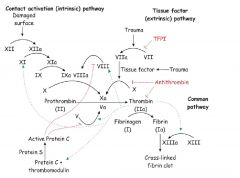
Intrinsic + Common
Hemophilia A, B |
|
|
|
Thromboplastin time mesures…
|
Common pathway
|
|
|
|
Pt c/ atropic glossitis and dysphagia 2/2 esophageal webs
May be due to _ and have increased risk of neoplasm_ |
Plummer-Vinson = anemia, atrophic glossitis, esophageal webs
2/2 iron deficiency RF for sq carcinoma of esophagus |
|
|
|
Hypoplastic thumbs
Absent radii Aplastic anemia Cafe-au-Lait spots short stature Disease, inheritence, pathogenesis |
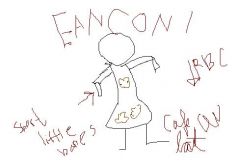
"R"anconi Anemia:
AR inheritence Absent Radii Alkylating agents + Radiation => BM DNA more susceptible |
|
|
|
Rheumatoid arthritis, Splenomegaly, Granulocytopenia,
skin lesions Dz (differential for chronic neutropenia + splenomegaly is 3 things..) Tx |
Felty's syndrome
(chronic neutropenia + splenomegaly = Felty, Gaucher's, sarcoid) Complications: infections, hypersplenism, hyperpigmentation, cutaneous ulceration Tx for RA: NSAIDS. DMARDS = hydroxychloroquine, sulfasalazine, methotrexate, azothioprine (2nd line: rituximab, leflunomide) |
|
|
|
Carcinomas having tendency to metastasize to bone
|
"Prostate Tumors Love Killing Bone":
Prostate Thyroid Lung Kidney Breast (this doesn't count sarcomas!!!) |
|
|
|
Pt in 20's-30's c/ recurrent bacterial respiratory infections
Dz Course Increased risk of _-type illness, _-type cancer Dz Dx: measure _ Tx |
Common variable immunodeficiency
Combined B, T-cell defect Ig levels drop in 20's -30's RF for lymphoma, autoimmune dz Dx: quantitative Ig level -> confirm c/ B- and T-cell subsets Tx: IVIG |
|
|
|
Young pt (<1 or >10) c/ fever, petichiae, ecchymoses, CNS infiltrate. Lymphoblasts. WBC > 50,000 Bone pain
Dz Tx |
ALL
Tx: 85% of children achieve remission c/ chemotx Avoid tumor lysis syn: allopurinol, IV fluids |
|
|
|
Fever, petechiae, ecchymoses, lymphadenopathy, splenomegaly.
|
AML
|
|
|
|
Middle-aged . young pt c/ anemia, splenomegaly, LUQ pain, +/- constitutional sx
WBC maybe >100,000 c/ granulocytes @ all stages; +/- hyperviscosity syndrome Low leukocyte alk phos High LDH, uric acic, B12 Philadelphia chromosome = t(9;22) Dz Tx: 1st/Chronic stage vs. 3rd/Blast phase |
CML
Chronic phase => Imatinib = Gleevac = bcr-abl tyr kinase inhibitor. Allogenic stem cell tx in young pts Blast phase => treat like acute leukemia or c/ dasatinib + hematopoietic stemm cell tx. |
|
|
|
Elderlypt c/ insiduous sx of low Ig, infections. Lymphocytes predominate, esp. CD5 non-Ab producing B cells
Warm-Ab hemolytic anemia Smudge cells on peripheral smear Lymphadenopathy, hepatosplenomegaly |
CLL
Lymphocytes predominate, esp. non-Ab producing B cells Hemolytic anemia |
|
|
|
Huntington's:
Involves _ portion of brain Transmission |
Hunt 4 A Date
Huntington's Chromosome 4, AD cauDate |
|
|
|
Medial calcific stenosis, "gooseneck lumps" in small-medium sized arteries
|
Monckeberg;s arteriosclerosis
|
|
|
|
Asian child c/ fever, conjunctivitis, maculopapular rash.
Consider dx of __ What to r/o a __ |
Kawasaki = mucocutaneous lymph node syndrome
"CRASH + Burn" Conjunctivitis Rash cervical Adenopathy Strawberry tongue Hands + feet are red, swollen, flaky Burn: fever >40 deg. x 5 days Coronary artery aneurysms in subacute phase (starts after 1-2 weeks) Tx: 1. High-dose Asa for fever, inflamm IVIG => prevent aneurysms 2. Low-dose aspirin x 6 wks Anticoag for pts c/ coronary aneurysm |
|
|
|
Female c/ polymyalgia rheumatica, new headaches, then vision loss in one eye
Dz Tx |
Giant cell arteritis = temporal arteritis
Subacute granulomatous inflamm of aorta, extenal carotid esp. temporal branch, vertebral arteries Complication: central retinal artery occlusion -> monocular blindness Tx: high-dose prednisone x 1-2 mo |
|
|
|
Small-medium vessel arteritis
Affects kidneys, heart, muscles, skin Disease = __ Therapy = __ |
Polyarteritis nodosa
Responds to steroids. Early dx and tx may prevent blindness. |
|
|
|
hirsuitism/virilization
testosterone >70 ng/mL DHEAS <7 ng/mL differential workup |
PCOS
late-onset CAH Cushing's syn no further workup/ r/o CAH, Cushings |
|
|
|
Acetyl choline R’s in NM end plate
|
Myasthenia gravis
|
|
|
|
"mosaic" lamellar pattern in bone of femur, skull, axial skeleton
+/- bone pain, hearing loss Normal Ca2+, P High Alk phos High urine hydroxyproline Dz Suspected to be 2/2 Most sensitive test Complications Tx |
Paget's
excessive resorption and formation of bone 2/2 latent viral infection? Radionuclide bone scan = most sensitive test Complications: fractures, cardiac coplications Osteosarcoma in up to 1% Tx: bisphosphonates, calcitonin to slow resorption Pain relief c/ acetaminophen, NSAIDs |
|
|
|
anti-Centromere Ab's
|
CREST = sclerosis of fingers, forearm, face
Calcinosis, Raynaud's, Esophageal dysmotility, Sclerodactyly, Telangiectasias |
|
|
|
HHV-7 is ass'd c/ skin disease...
|
pityriasis rosacea
mini-epidemics in young adults herald patch -> secondar exanthem c/ "cigarette paper" scale, christmas tree on back heals s/ tx in 2-3 wks. severe => short course of systemic corticosteroids |
|
|
|
Pemphigus vulgaris
widespread painful erosions of skin, mucus membranes Nikolsky's sign (can make new blisters beside old ones) Bx => acantholysis Tx: wound care High dose systemic corticosteroids Azathioprine, other anti-metabolites if steroids not well-tolerated |

50 y/o pt c/o blisters
Can produce intraepidermal blisters by rubbing area adjacent to current blisters (+) anti-desmoglein Ab's on immunofluorescence, ELISA Dz Tx |
|
|
|
anti-Gliadin Ab's
|

Celiac
Proximal small bowel only Abnl xylose test Increased risk of T-cell lymphoma |
|
|
|
anti-Histone Ab's
what disease? |
Drug-induced SLE
CHIMP Q: Chlorpromazine = phenothiazine/antiemetic Hydralazine = arteriole dilator for CHF INH Methyldopa = presynaptic adrenergic release blocker = Penicillamine = for RA, juvenile polyart.arthritis, scleroderma Procainamide, Quinidine = IA = for atrial flutter/fib, PSVT, vtach = prolongs repolarization of purkinje |
|
|
|
Child c/ poor retinal development, GU abnormalities, MR
Dz Should be concerned a/b malignancy _ |
WAGR:
Wilm's tumor Aniridia GU abnormalities mental Retardation |
|
|
|
anti-Microsomal Ab's
|
Hashimoto’s thyroiditis
|
|
|
|
anti-Mitochondrial Ab's
Disease Population population lab change Tx |
1° Biliary cirrhosis
Destruction of intrahepatic bile ducts Middle-aged women c/ hx of auto-immune dz, esp. CREST + scleroderma Complications: sclerosing cholangitis High Alk phos Sx: fatigue, pruritis, hypercholesterolemia, steatorrhea, xanthomas Tx: ursodeoxycholic acid slows dz progression Cholestyramine for pruritus Liver tx |
|
|
|
anti-Nuclear Ab's:
differential = 5 diseases, in order of how commonly they present c/ ANA's |
SLE 80-90%
Sjogrens 60% Scleroderma 30% Dermatomyositis 30% RA 30% |
|
|
|
anti-Neutrophil Ab's
|
Vasculitis (c-ANCA, p-ANCA)
|
|
|
|
auto-Ab's against Neutrophil cytoplasm
|
Wegener’s granulomatosis
|
|
|
|
Auto-Ab against proteins involved c/ intracellular Ca2+ release
|
Eaton-Lambert
similar to myasthenia gravis More strength c/ repitition |
|
|
|
anti-Platelet IgG
#1 immunologic disorder in women of childbearing age +/- hx of lymphoma, leukemia, SLe, HIV, HCV what type of hypersensitivity? Tx Pregnancy risk |
ITP = type 2 hypersensitivity
Chronic form => adults Diagnosis of exclusion No tx if platelets > 20,000 Corticosteroids, IVIG -> splenectomy if still needing steroids @ 3-6 months Pregnancy: risk of fetal thrombocytopenia |
|
|
|
TSH receptor
|
Graves’s
|
|
|
|
Anti-Jo-1 (2 diseases)
|
Polymyositis, dermatomyositis
|
|
|
|
CEA
marker for 3 cancers… |
"oncofetal Ag" = manifestation of de-differentiation
Adenocarcinoma of colon, pancreas, lung |
|
|
|
alpha fetoprotein (3 things it can mean)
|
hepatoma
yolk sac tumor (#1 testicular tumor in kids)+C503 endodermal sinus tumors twins anencephaly |
|
|
|
Alk phos (3 things it can mean)
|
High osteoblast activity
Bone mets Obstructive biliary dz Paget's (bones enlarged, radiolucent, excessive resorption, replacement) Seminoma |
|
|
|
S-100 is associated with 3 cancers... (in 2 systems)
|
Ectoderm-derived
MAN Melanoma (lentigo malinga = horizontal; nodular = vertical) Astrocytoma Neural tumors |
|
|
|
CA-19-9
|
pancreatic cancer
|
|
|
|
calcitonin
|
medullary carcinoma of thyroid
|
|
|
|
5-HIAA = 5-hydroxyindoleacetic acid
|
carcinoid syn
due to metastatic carcinoid tumor carcinoid syn can cause niacin deficiency due to B3 being used to make serotonin |
|
|
|
Decreased percussion
increased tactile fremitus (more vibration than expected when pt speaks) bronchial breath sounds (short inspiration, long expiration) Wet crackles |
Consolidation, e.g. typical pneumonia
Sounds are transmitted better through consolidation (which includes alveoli) than through areas whnere infiltrates are mostly intersitial + spare the alveoli Bronchial breath sounds due to compression of bronchi by infiltrate |
|
|
|
Hyperresonance to percussion
Dry crackles |
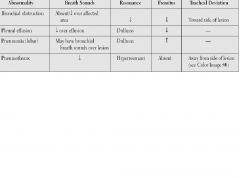
Bullous emphysema
large air-filled bullae @ periphery of repiratory unit (repiratory bronchiole, alveolar duct, alveoli) |
|
|
|
Chronic bronchitis is seen in two major areas: In _ => symptoms of _, _
In _ => _ |
1. segmental bronchi: inflammation causes increased mucous production (productive cough), sibilant rhonchi (whistling sounds that clear c/ cough)
2. terminal bronchioles: inflammatory airway obstruction => wheexzing, air-trapping |
|
|
|
Dullness to percussion
No tactile fremitus or crackles |
Pleural effusion
fluid in pleural cavity blocks sound transmission from parenchyma |
|
|
|
Hyperresonance to percussion
No tactile fremitus or crackles |
Pneumothorax
lung collapses due to open communication b/w pleural cavity + airway usually due to bleb rupture in or directly beneath pleura |
|
|
|
What lung problem?
Pleuritic chest pain Pleural friction rub Hemorrhagic pleural effusion |
PE
small embolus to peripheral pulm arterial branch => wedge-shaped hemorrhagic infarction extending to pleural surface |
|
|
|
Whipple's dz
Mneumonic |
WHIPPLES
Whipplei Hypothalmus Intestine PAS (+) macrophages PCR (+) Lymphadenopathy Extrapyramidal sx Septran tx |
|
|
|
2 organisms causing post-viral pneumonia
|
Staphylococcus
H. influenzae |
|
|
|
Lobar pneumonia organisms (3)
|
Pneumococcus => ceftriaxone, macrolide, or quinolone
Klebsiella => 3G or quinolone Legionella (LDH >400, hyponatremia, CNS changes, diarrhea) => doxycycline, macrolide, or quinolone |
|
|
|
Lung cancer:
Central Neuroendocrine + Paraneoplastic syndromes ACTH, ADH, Lambert-Eaton Metastasizes via mediastinal + hilar LN's |
Small cell carcinoma
|
|
|
|
Lung cancer:
Central Hilar mass arising from bronchus Strongly correlated c/ smoking "Keratin pearls", intracellular bridges ___ hormone -producing Well-localized, metastasizes slowly outside of thorax |
Squamous cell carcinoma
SSS = Squamous, Sentral, Smoking PTH-producing |
|
|
|
Open-angle glaucoma:
dz of trabecular mesh -> obstructs drainage most common glaucoma painless, insidious. B-block, latanoprost, acetazolamide, pilocarpine |
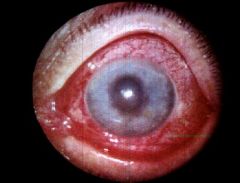
Af Am pt > 40 y/o c/ hx DM, myopia
Needing frequent contact lens changes. Headaches, bilat. peripheral visual changes Fundoscopic exam => cupping of optic disk |
|
|
|
Lung cancer:
Peripheral @ previous site of lung injury/inflammation Clara cells --> Type 2 pneumocytes Multiple densities on CXR #1 lung cancer in non-smokers |
Adenocarcinoma:
Bronchial Bronchoalveolar |
|
|
|
Lung cancer:
Peripheral Anaplastic ass'd c/ gynecomastia Dz Prognosis |
Large cell carcinoma
least common poor prognosis |
|
|
|
Top 2 causes of pulmonary HTN
|
1. COPD
2. L to R shunt normal pulm artery P ~12 mm Hg HTN is > 24 mm Hg or >35 mm Hg in exercise Pulm HTN causes cor pulmonale (CP is defined as originating in the pulm circulation, due to tissue damage, chornic hypoxic pulm vasoconstriction), RV failure |
|
|
|
Intersitial lung dz/fibrosis
2/2 inflamm and/or fibrosis of interalveolar septum Advanced disease has cystic spaces in periphery = "honeycombing" Causes: idiopathic, collagen vascular dz, granulomatous dz, drugs, hypersensitivity, pneumoconiosis, eosinophilic pulm dz Iatrogenic: busulfan, bleomycin, nitrofurantoin, amiodarone, radiation, long-term high O2 Tx: support. corticosteroids for inflamm dz |
Pt c/ rapid, shallow breathing, nonproductive cough
Inspiratory squeaks, "velcro" crackles "Honeycombing" on CXR Low TLC, FVC, DLco Normal FEV1/FVC Dz Can be caused by 2 alkylating agents _, Antibiotic _, anti-arrhythmic _, long-term high O2, radiation |
|
|
|
Therapeutic index
|
median toxic dose/ median effective dose
|
|
|
|
Normal lab value:
pO2 |
90 (75-100)
|
|
|
|
Normal lab value:
HCO3- |
25 (22-28)
|
|
|
|
Normal lab value:
Cl- |
100 (95-105)
|
|
|
|
Normal lab value:
K+ |
4.2 (3.5-5)
|
|
|
|
Lithium:
main indication 2 major side effects |
Lithium
For manic depression SE: nephrogenic DI (don't respond to ADH), hypothyroid |
|
|
|
Normal peripheral blood:
% eosinophils |
3% (0-5%)
|
|
|
|
Genital lesions: what are these and how are they treated?
#1: papule -> beefy red ulcer c/ rolled edge of granulation tissue. painless. Bx => donovan bodies #2: multiple, painful, irregular, well-demarcated necrotic ulcers. inguinal lymphadenopahty |
#1: granuloma inguinale = calmmatobacterium granulomatis
#2: chancroid = haemophilus ducreyi Tx for either: Doxy 100 mg BID or Azith 1g weekly x 3 wks |
|
|
|
Normal peripheral blood:
platelet count |
275,000 (150,000-400,000)
|
|
|
|
What has this patient overdosed on?
what is the tx? drowsiness, confusion dry mouth, dilated pupils, blurred vision, decreased BS, urinary retention |
diphenhydramine
antidote = cholinesterase inhibitor = physodstigmine |
|
|
|
Normal peripheral blood:
% lymphocytes |
30% (25-35%)
|
|
|
|
Normal peripheral blood:
% bands, monocytes |
4% (3-5%)
|
|
|
|
Normal peripheral blood:
Hct (M, F) |
Male: 0.47 (0.41-0.53)
Female: 0.41 (0.36-0.46) |
|
|
|
Normal peripheral blood:
Hgb (M, F, baby) g/dL |
Male: 15.5 (13.5-17.5)
Female: 14 (12-16) Infant: 17 (14-20) |
|
|
|
Normal lab value:
Cr mg/dL |
0.9 (0.6-1.2)
|
|
|
|
Adult pt has recently taken phenytoin, sulfonamide, allopurinol, carbamazepine, barbiturate, or NSAID
Now c/ hot, tender, erythematous macules Loose skin patches Blistering of oral mucosa Dz Tx |
Toxic epidermal necrolysis
Tx: supportive Controversial tx: systemic steroids, IVIG in early dz |
|
|
|
Normal lab value:
AST U/L |
normal AST < 35 U/L
|
|
|
|
Normal lab value:
Amylase U/L |
75 (25-125)
|
|
|
|
hirsuitism/virilization
DHEAS >7 ng/mL disease differential workup |
adrenal tumor
cushing's syndrome adrenal CT dexamethasone suppression test |
|
|
|
Type 2 diabetes screening:
when to start, frequency normal fasting #'s |
no RF's: start @ 45, test q3 yrs
Impaired fasting glucose: >110 mg/dL => test more frequently Type 2 DM: >125 mg/dL |
|
|
|
Normal lab value:
Ca2+ |
9.3 (8.4-10.2)
|
|
|
|
annular pruritic cutaneous rash that may be recurrent
tends to involve palms, soles starts as erythematous macules -> become centrally clear, develop a blister Dz Most are triggered by _ 2 other causes are _ Severe disease can progress to 2 worse conditions... (see hint) |
Erythema multiforme
most triggered by HSV other triggers: mycoplasma, drugs Severe EM can -> TEN = full-thickness epidermal damage + sloughing (2/2 sulfa, allopurinol, phenytoin, carbamezepine) or Stevens-Johnson = ill c/ involvement of >1 mucosal surface Tx: symptomatic NO BENEFIT TO STEROIDS HSV => suppressive tx c/ acyclovir |
pt usually has hx of recurrent labial herpes
|
|
|
Fever
Anemia Thrombocytopenia Renal problems Neurologic dysfunction |
TTP
|
|
|
|
"Blue bloaters"
|
Chronic bronchitis
Chronic resp irritation/infections Hypertrophy of submucosal glands |
|
|
|
"Fixed split S2": 2 possibilities
|
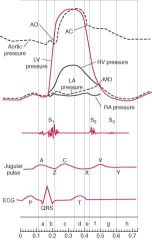
ASD or VSD
Create L to R shunt that increases blood flow to the R heart => pulmonic valve closes AFTER aortic, regardless of inspiration or expiration (normally, inspiration causes a delay in pulmonic valve closure, increases the S2 split) |
|
|
|
"hair on end" apprearance on x-ray
|
Extramedullary hematopoeisis:
β thalassemia Sickle cell |
|
|
|
"Machine-like" murmur
|
PDA
|
|
|
|
"Pink puffers" = emphysema
Panacinar is located in _, due to _ Centrilobular is located in _, due to _ |
Panacinar: lower lobes, entire acinus is dilated. Anti-trypsin deficiency
Centrilobular: upper lobes, dilation of bronchioles only. RF =smoking |
|
|
|
"Slapped cheeks"
Organism Fetal effect |
Erythema infectiosum = 5th disease = Parvovirus B19
ssDNA (smallest DNA virus), linear, nucleocapsid, no envelope Aplastic crises in sickle cell Hyrops fetalis |
|
|
|
"Soap bubble" appearance on x-ray:
_ tumor of bone Commonly located @ _ Age_ Histology |
Giant cell tumor of bone
Benign primary bone tumor, esp. distal femur Epiphyseal end of long bones 20-40 y/o Spindle-shaped cells c/ multinucleates giant cells |
|
|
|
"Spike + dome" on EM:
Kidney disease_ |
Membranous glomerulonephritis
|
|
|
|
"Strawberry tongue"
Etiology |
Scarlet fever
Toxigenic grp A β-hemolytic strep = Strep pyogenes Toxigenic also ass'd c/ TSS |
|
|
|
"String sign" on x-ray
|
Crohn's disease
|
|
|
|
"Thumb sign on lateral x-ray
|
Epiglottitis
Haemophilus influenzae |
|
|
|
"Tram track" appearance on LM
Disease Classified as a _ syndrome Population Prognosis |
Membranoproliferative glomerulonephritis
Nephritic syndrome Sub-ENDOthelial humps on EM Young adults Poor prognosis: slowly progresses to renal failure |
|
|
|
"Water hammer" pulse
What lesion 2 causes |
Aortic regurgitation
Due to endocarditis, syphilis Early high-pitched diastolic "blowing" murmur c/ "pistol shots" in femoral Wide pulse P |
|
|
|
# 1 congen cardiac anomaly + its direction
|
VSD (L--> R)
|
|
|
|
#1 acute renal failure
initial reversible oliguria => hyperkalemia 3 main causes…. |
1. Ischemia: low BP from sepsis, trauma
2. Myoglobinuria: crush injury, exercise 3. Toxicity to prox renal tubule: mercuric chloride, gentamycin, ethylene glycol |
|
|
|
#1 adrenal tumor in adults
|
Pheochromocytoma:
benign chromaffin cells (neural crest origin) Neurofibromatosis MEN2 (parathyroid), MEN3 (mucosal neuromas = oral/intestinal ganglioneuromatosis) (MEN 2 + 3 have ret gene, pheochromocytoma, papillary of thyroid) |
|
|
|
#1 adrenal tumor in kids
location diagnosis |
Neuroblastoma:
malignant can occur anywhere along sympathetic chain, but adrenal medulla is most common HVA (dopamine degradation product) in urine N-methyl transferase is ONLY in adrenal medulla. Makes epi. COMT: Epi --> metanephrine MAO: metanephrine --> VMA HVA, VMA, metanephrines are secreted in urine |
|
|
|
#1 benign bone tumor:
Consists of _ Population |
Osteochondroma
Mature bone c/ cartilage cap often @ long metaphysis M> F <25 y/o Rare malignant transformation |
|
|
|
#1 benign breast tumor
|
Fibroadenoma
Small, mobile, firm mass c/ sharp edges increase in size + tenderness in pregnancy Not a pre-cancerous lesion |
|
|
|
#1 benign ovarian tumor
|
Serous cystadenoma:
20% of ovarian tumors Can be bilateral Lined c/ fallopian-type epithelium |
|
|
|
#1 brain tumor in kids
Type Location What type of cells Complication Therapy |
Medulloblastoma (cerebellum)
a PNET = primitive neuroectodermal tumor 4th ventricle compression -> hydrocephalus Rosettes or perivascular pseudorosettes Radiosensitive |
|
|
|
#1 breast cancer
|
infiltrating ductal
firm, fibrous mass |
|
|
|
#1 cardiac tumor in kids
Asscocated c/ disease_ |
Rhabdomyoma
Ass'd c/ tuberous sclerosis Tuberous sclerosis: presenting features "Zits, Fits, Deficits": Zits: adenoma sebaceum Fits: seizures Deficits: neuro deficits |
|
|
|
#1 Cardiomyopathy
|
Dilated cardiomyopathy = 90%
ABCD = Alcohol Beri-Beri, Baby-having (pregnancy) Coxsackie B, Cocaine, Chagas Doxorubicin Heart dilates + looks like a balloon on CXR Inherited form: mutated cytoskel proteins, Alk Phos (e.g. X-linked dystrophin mutation) |
|
|
|
#1 cause of abdominal or decending aortic aneurysm
|
Atherosclerosis
|
|
|
|
#1 cause of ascending aortic aneurysm
|
Tertiary syphilis
CV disease after 10-20 yrs of untreated dz Gummas: indolent granulomatous lesions on skin, liver, skel system, musculocutaneous tissue Neurosyphilis = tabes dorsalis : posterior column demyelination -> decreased proprioception, (+) Romberg, wide gait Argyll-Robertson pupil = lesion in PRETECTAL area of SUPERIOR COLLICULUS: accomodates (parasymp => pupil constricts + ciliary body constricts the lens to focus), but no rxn to light (direct path from optic tract to midbrain) Charcot joints Stroke s/ HTN |
|
|
|
#1 cause of congential adrenal hyperplasia, and its symptoms
what are the 2 next most common forms of CAH? |
21 beta-hydroxylase deficiency: 2 rxns that create cortisol + mineralcorticoid precursors
Masculinization, female pseudohermaphroditism Salt wasting: low Na+, high K+, low BP 11 beta-hydroxylase deficiency => HTN (11-deoxycorticosterone = weak mineralcorticoid), masculinization 17 alpha-hydroxylase deficiency => HTN, female s/ maturation |
|
|
|
#1 cause of death in CML
|
Blast crisis = acceleration of CML to AML
Normally more mature myeloid cells: neutrophils, metamyelocytes |
|
|
|
#1 cause of death in SLE
|
Lupus nephropathy: wire loop lesions, sub-EPIthelial immune complexes
Pattern of membranous glomerulonephritis |
|
|
|
#1 cause of dissecting aortic aneurysm
|
HTN
|
|
|
|
#1 cause of hemochromatosis
2 complications |
Multiple transfusions
complications: CHF, hepatocellular carcinoma "HaemoChromatosis Can Cause Deposits Anywhere": Hypogonadism Cancer (hepatocellular) Cirrhosis Cardiomyopathy Diabetes mellitus Arthropathy |
|
|
|
#1 cause of hepatocellular carcinoma
|
Cirrhosis, often with Hep B/C
ABC of etiology: Aflatoxins Hep B Cirrhosis ABC of features: alpha Feto-protein Bile-producing (DDx from cholangiocarcinoma) Commonest primary liver tumor |
|
|
|
#1 cause of hypoparathyroidism
|
Thyroidectomy
|
|
|
|
#1 cause of hypopituitarism
|
Adenoma
|
|
|
|
Pediatric rashes ass'd c/ fever: time of appearance after fever onset
Which disease shows rash on which day? |
"Really Sick Children Must Take No Exercise":
# of days after fever onset when appears: 1 Day: Rubella 2 Days: Scarlet fever/ Smallpox 3 Days: Chickenpox 4 Days: Measles (Koplik spots 1 day rash) 5 Days: Typhus & rickettsia (this is variable) 6 Days: Nothing 7 Days: Enteric fever (salmonella) |
|
|
|
#1 cause of MR
|
Trisomy 21
|
|
|
|
#1 cause of myocarditis
|
Coxsackie B:
Picornavirus, ssRNA, no envelope, icosahedral, makes large peptide that is cleaved into viral proteins ("PERCH on the "pico" of the mtn) myocarditis, aseptic meningitis, herpangina (febrile paralysis), hand-foot-mouth dx |
|
|
|
#1 cause of opening snap
|
mitral stenosis
|
|
|
|
#1 cause of primary amenorrhea
|
Turner's
|
|
|
|
#1 cause of primary hyperaldosteronism
|
Conn's = adrenoma of adrenal cortex => low renin, low K+, HTN, met alkalosis
|
|
|
|
Receptors linked to Gq pathway
|
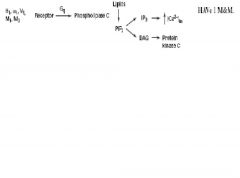
HAVe 1 M&M
|
|
|
|
#1 cause of secondary HTN
|
renal disease
|
|
|
|
#1 cause of secondary hyperparathyroidism
|
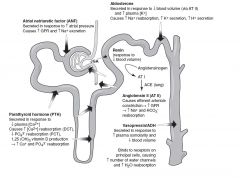
Chronic renal failure -> hypocalcemia -> parathyroid hyperplasia
Blood: low Ca, high P "renal osteodystrophy" |
|
|
|
#1 class of ovarian tumor in women , 20 y/o
specific tumors in that class, how to tell them apart |
germ cell tumor
"Doctor Examined The Ovaries": Dysgerminoma (hCG, ~seminoma in males, malignant) Endomdermal sinus (AFP > anti-trypsin, kids) Teratoma (90% of ovarian germ cell tumors; dermoid, immature, + struma ovarii = thyroid tissue) Ovarian choriocarcinoma (hCG, syncitiotropoblasts are hyperchromatic) |
|
|
|
#1 congenital cardiac anomaly
|
VSD (L to R)
|
|
|
|
#1 constrictive pericarditis
|
Tuberculosis
Starts as hemorrhagic pericarditis, can lead to chronic adhesive or constrictive pericarditis |
|
|
|
#1 dietary deficit
|
Iron
|
|
|
|
#1 endometrial cancer
|
Serous adenocardinoma
may be no bleeding RFs: >40 y/o, long childbearing period, nulliparous, obese |
|
|
|
#1 glomerulonephritis in adults
|
IgA nephropathy = Berger's
|
|
|
|
5 Beta blocker contraindications, cautions
|
Beta-blockers: main contraindications, cautions ABCDE:
Asthma Block (heart block) COPD Diabetes mellitus Electrolyte (hyperkalemia) |
|
|
|
#1 leukemia in adults
|
AML
|
|
|
|
#1 location for colon diverticula
true vs. false diverticula |
Sigmoid
true diverticula = all 3 gut layers (mucosa, muscularis, serosa) pseudodiverticula = mucosa + submucosa; esophagus, stomach, duodenum, colon - where vasa recta perforate the muscularis externa |
|
|
|
#1 lysosomal storage disorder
|
Gaucher's:
Βeta-glucocerebrosidase: Glucocerebroside --> Cerebroside AR inheritance Hepatosplenomegaly, aseptic necrosis of femur, bone crises Gaucher's cells = macrophages |
|
|
|
#1 malignant bone tumor
"sunburst" lytic lesions on CT and/or MRI seen in metaphyses of long bones population 4 RFs 20% have mets to _ Tx |
Osteosarcoma
male adolescents Ass'd c/ Paget's dz of bone, bone infarcts, radiation. Familial retinoblastoma 20% have lung mets Resection + post-op chemo for micromets |
|
|
|
#1 malignant ovarian tumor
|
Serous cystadenocarcinoma:
50% of ovarian tumors Often bilateral |
|
|
|
#1 malignant skin tumor
Esp. on eyelid Multiple lesions on non-sun exposed areas suggests exposure to _ or inheritance of _ |

Basal cell carcinoma
Locally invasive, rarely metastasizes Pearly papules, "palisading nuclei" Arsenic exposure or BCC nevus syn => BCC on non-sun exposed areas |
|
|
|
#1 motor neuron disease
|
ALS:
Spinocerebellar motor neuron disease Atrophy, spasticity, weakness = UMN and LMN signs No sensory deficit Can be caused by defect in SOD |
|
|
|
#1 nephrotic syndrome
population presentation histology |
Membranous:
young pt, insidious onset sub-EPIthelial immune complexes Diffuse GBM thickening Granular pattern on IF, "spike + dome" on EM |
|
|
|
#1 NH lymphoma in adults
|
Follicular = small cleaved cell:
CD10 B cells t(14;18) => bcl-2 (blocks apoptosis) Indolent waxing/waning, non-painful lymphadenopathy, hard to cure NLH's tend to affect younger adults, no hypergammaglobiulinemia, multiple nodes, non-contiguous spread |
|
|
|
#1 NH lymphoma in kids:
_ cells Commonly presents c/ _ + _ |
Lymphoblastic lymphoma
T-cell Commonly presents c/ ALL + mediastinal mass very aggressive |
|
|
|
#1 opportunistic infection in AIDS
Non-productive cough, dyspnea, fever Increased A-a gradient Bilat interstitial "ground glass" infiltrates Can also be disseminated |
Pneumocystis carinii:
Diffuse interstitial pneumonia Inhaled yeast Dx: methamine silver stain of lung tissue (green) Get ABG Tx = TMP/SMX x 21 days, (or primaquine, clinda if sulfa allergy) Prednisone taper if PaO2 <60mm or A-a gradient >35 PPx: CD4 <200 cells/mL or oral candidiasis |
|
|
|
Name 4 major opportunistic GI diseases in AIDS:
1. Neoplastic/Viral 2. Parasite 3. Bacterial 4. Viral |
Non-Hodgkin's lymphoma 2/2 EBV
Mycobacterium avium-intracellulare complex Cryptosporidium (CD4 < 180, acid-fast oocysts) CMV colitis |
|
|
|
If an IV drug user has osteomytelitis, suspect 2 organisms...
Tx |
Staph aureus: clinda + cipro, amp/sulbactam, oxacillin/nafcillin, or vancomycin
Pseudomonas: cefTAZadime Tx: debridement -> IV abx x 4-6 wks |
|
|
|
#1 pancreatic tumor:
_ of _ Tumor marker RFs Presentation (2 signs, 2 sx) Tx |
Adenocarcinoma of the head of the pancreas = 75%
CA 19-9 RFs: smoking, high-fat diet chronic pancreatitis, 1st deg. family hx, Jewish, Af-Am males **** EtOH IS NOT A RF ****** 1. Ab pain radiating to back 2. Wt loss 3. Trousseau's = migratory thrombophlebitis 4. Courvoisier's sign = palpable nontender gallbladder Tx: Whipple for the ~15% that aren't metastatic Chemo: 5-FU + Gemcitabine |
|
|
|
elderly pt c/
Hypercalcemia, renal insufficiency, anemia Lytic bone lesions Serum/urine protein electrophoresis => gamma spike IgG > IgA = M proteins Lytic bone lesions BM bx => >10% plasma cells Bence-Jones (light chains) in urine Rouleaus of RBCs Dz, Tx |
Multiple myeloma
1. >10% plasma cells in marrow 2. Lytic bone lesions 3. Serum/urine M protein Bone scan (measures osteoBLASTIC) activity may be (-) Chemotx: prednisone + melphalan = oral alkylating agent Myeloma cells may be resistant 2/2 MDR gene Stem cell tx to support more intensive chemo |
|
|
|
#1 primary cardiac tumor
Location increased systemic venous pressure on inspiration |
Myxoma
90% in atria, L>R "Ball + Valve" Kussmaul's sign = increased systemic venous pressure on inspiration |
|
|
|
#1 primary liver cancer
tumor marker is ... |
Hepatoma/Hepatocelluar carcinoma
RF's: aflatoxin B1, Hep B/C, Wilson's, hemochromatosis, alpha1anti-trypsin defic, EtOH cirrhosis Tender hepatomegaly, ascites, polycythemia, hypoglycemia, Budd-Chiari Hematogenous dissemination alpha fetoprotein |
|
|
|
#1 renal cancer
Associated with diseases (2)_ 2 other RF's Typical population, presentation, paraneoplastic syndromes |
Ass'd c/ VHL (deletion on chromosome 3p), acquired polycystic kidney dz
Other RF's: smoking, obesity Paraneoplastic: ectopic Epo, ACTH, PTHrP, prolactin Men 50-70 y/o |
|
|
|
#1 stomach cancer is...
2 types are... RFs are ... Tx is ... |
Gastric adenocarcinoma
Intestinal: metaplastic gastric mucosa. RF's: diet high in nitrites/salt, H. pylori, chronic gastritis Diffuse: poorly-diff. RFs unk. Early aggressive local spread, mets to LNs + liver Tx: surgery Krukenberg's tumor = bilateral ovarian mets #2 cause of cancer death worldwide |
|
|
|
#1 supratentorial brain tumor in kids
|

Craniopharyngioma
Benign Derived from Rathke's pouch (depression in roof of developing mouth; gives rise to anterior pituitary) Calcification is common Bitemporal hemianopsia => can be confused c/ pituitary adenoma |
|
|
|
#1 testicular tumor
Presentation, population Tumor marker |
Seminoma
Malignant Painless testicular enlargement 40-50 y/o Placental Alk Phos (AFP for other testicular cancers) Germ cell = 95% of testicular tumors (others are embryonal carcinoma, yolk sac = endodermal sinus tumor) |
|
|
|
#1 tracheo-esophageal fistula
|
Upper esophagus = blind pouch
Lower esophagus connects to trachea |
|
|
|
Hirsuitism/virilization c/ testosterone >200 ng/dL
disease workup |
ovarian neoplasm
adrenal CT, pelvic US |
|
|
|
#1 vasulitis
|
Temporal arteritis:
elderly females, 50% have polymyalgia rheumatica small-medium arteries, branches of carotid focal granulomatous inflammation of media increased ESR risk of ipsilateral blindness by thrombosis of opthalmic artery tx = corticosteroids |
|
|
|
#1,2 viral encephalitis
For #1: Dz, Dx, Tx (see hint for #1) |
1. HSV: RBCs in CSF s/ hx of trauma
Dx: PCR Tx: IV acyclovir 2. Arbovirus also enteroviruses CMV => IV ganciclovir +/- foscarnet |
HSV
|
|
|
pt c/o lethargy, wt loss, Reyanud's
Neuro changes: AMS, periph neuropathy, blurred vision Skin, GI, kidney, or lung prbs High ESR, uric acid, LDH Alk phos PAS (+) IgM deposits around nucleus Dz is _ Dx by _ Tx is _ (See hint) |
Waldenstrom's macrolobulinemia
precursor = MGUS high IgM -> hypervisosity, cold agglutinin dz -> autoimmune hemoytic anemia Dx by BM bx => Dutcher bodies Tx: excess IgM removed by plasmaphersis Treat lymphoma c/ chemo |
a malignant monoclonal gammopathy
high IgM |
|
|
#2 testicular germ cell tumor
Hemorrhage, necrosis |
Embryonal carcinoma
Presents c/ pain, mets Pts younger than c/ seminoma |
|
|
|
_ of hypothalamus produces oxytocin
|
PARavenricular nucleus => PARturition
|
|
|
|
_ type pericarditis:
viral infections, uremia, rheumatic fever |
Fibrinous
|
|
|
|
2 estrogen-secreting ovarian tumors
|
1. Granulosa (Call-Exner bodies, precocious puberty, endometrial hyperplasia)
2. Thecoma (Sertoli-Leydig secrete androgens) |
|
|
|
2 High-pitched "blowing" murmurs:
Holosystolic Early diastolic |
Mitral regurgitation => holosystolic
Aortic regurgitation => early diastolic |
|
|
|
2 most common cancers in kids
|
1. ALL: lymphoblasts. Can spread to CNS, testes
2. Cerebellar medulloblastoma: primitive neuroectodermal tumor 4th ventricle compression --> hydrocephalus. Rosettes or perivascular pseudorosettes. Roadiosensitive |
|
|
|
Cushing's syn:
Screening test 2 most common causes |
Screening: 24-hr free urine cortisol or overnight low-dose dexamethasone suppression test (abnl if AM cortisol is still high)
1. Corticosteroid therapy (low ACTH) 2. Pituitary adenoma (high ACTH): high afternoon ACTH |
|
|
|
2 most common kidney stones
composition relationship to urine pH |
1. Ca Oxalate and/or Phosphate: Cancer, hyperparathyroid, hypercalcemia, milk-alkali syn. Tend to recur
2. Struvite = Ammonium Mg Phosphate: Proteus, Staph, Klebsiella. Staghorn calculi = nidus for UTI. Worsened by ALKaluria. Both radiopaque Uric acid = radiolucent, worsened by ACIDuria |
|
|
|
2 most common pituitary tumors
tx for #1 |
1. Prolactinoma: prolactin > 200 mg/dL
amenorrhea, galactorrhea, low libido, infertile. Tx = bromocriptine, cabergoline, pergolide (dopamine agonist) 2. Growth hormone adenoma (=somatotropic "acidophilic" adenoma?) |
|
|
|
AIDS pt from another country has a head CT c/ contrast:
ring-enhancing or calcified lesion Dz Tx |
Cystocercosis = infection c/ larval form of Taenia solium (pork tapeworm)
Tx: niclosamide or praziquantel |
|
|
|
3 most common cancers to metastasize
|
Lung (to brain, bone, liver) > Breast, Stomach
|
|
|
|
3 most common causes of primary hyperparathyroidism
Blood changes Urine changes Complication |
1. Adenoma
2. Hyperplasia 3. Carcinoma Blood: high Ca2+, low P Urine: high Ca, cAMP Can cause osteitis fibrosa cystica = von Recklinghausen's = brown, cystic, painful bone lesions |
|
|
|
H. pylori is associated c/ 2 gastric cancers..
|
H. pylori ->
1. Intestinal-type gastric adenoca = metaplastic gastric mucosa. Tx is surgery. 2. MALT gastric lymphoma = a NHL = monoclonal B cell proliferation. Tx is chemo. |
|
|
|
3 most common thyroid carcinomas
path findings RF Mets |
1. Papillary: Popular
Papillae (branching) Palpable lymph nodes Orphan Annie "Pupils" Psammoma = laminar Ca2+ collections Positive Prognosis RF = childhood irradiation 2. Follicular: hematogenous mets, good prognosis 3. Medullary: parafollicular C cells (calcitonin) MEN2 (parathyroid), MEN3 (mucosal neuromas = oral/intestinal ganglioneuromatosis) |
|
|
|
3 y/o has palpable flank mass.
What genetic change is likely? |
WT1 tumor supressor gene on chromosome 11
Wilm's = #1 renal tumor of early childhood |
|
|
|
4 causes of secondary hyperaldosteronism
cardiac, vascular, renal, hepatic |
1. CHF
2. Vena cava obstruction/constriction (atrial stretch R's) 3. Renal artery stenosis 4. Hepatic cirrhosis (angiotensinogen comes from liver) |
|
|
|
4 cell/tissue types that use glucose as sole energy source
|
RBCs (no mitochondria - can't use ketones)
Brain (can use ketones) Testes Renal medulla |
|
|
|
3 most common causes of holosystolic murmurs
|
VSD
Tricuspid regurgitation Mitral regurgitation |
|
|
|
4 most common sites for atherosclerosis
|
1. Ab aorta
2. Coronaries 3. Popliteal 4. Carotids |
|
|
|
4 most common sources of brain mets
Skull/dural mets suggest… |
Lung > Breast > RCC, GI
Skull/dural: breast, prostate, lung, neuroblastoma |
|
|
|
Pt c/ intermittent dysphagia for solids + liquids
No heartburn Barium swallow => distal "bird beak" narrowing Dx Possible infectious etiology _ Dx can be made via _ 4 therapies: invasive, 2 drugs, surgery |
Achalasia
Idiopathic > Chagas dz Dx: esophageal manometry Tx: pneumatic balloon dilation Botox injection Ca-channel blocker Myotomy = last resort |
|
|
|
sarcoidosis affects PTH by ...
|
sarcoidosis ->
increased conversion of 25-OH-vit D to 1,25-OH-Vit D in kidney -> suppresses PTH |
|
|
|
4 y/o girl c/ new onset of MR, stereotyped hand-wringing:
Disease Inheritence |
Rett
Girls only X-linked |
|
|
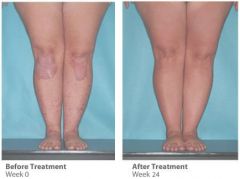
Acanthosis (epidermal hyperplasia) + scaling on knees, elbows.
Auspitz sign = bleeding after removal of scales what disease what changes to skin layers? |

Psoriasis
increased stratum spinosum decreased stratum granulosum |
|
|
|
Mutation to fibroblast growth factor R 3 => defective collagen synthesis + premature ossification of growth plate
Dz Inheritence _ Failure in _-type of bone growth _-type bones are normal |
Achondroplasia:
Failure in longitudinal bone growth normal skull, facial bones, axial skeleton AD |
|
|
|
Acrophobia
|
fear of heights
|
|
|
|
Acute hypersensitivity pneumonitis (fever, cough leukocytosis)
Type _ hypersensitivity |
Type 3
|
|
|
|
Acute megakaryocytic leukemia is in the _ class of AML
|
M7
|
|
|
|
Acyanotic congen heart defects
|
L --> R
VSD ASD (ostium primun, secundum) PDA |
|
|
|
Acyanotic/ Late cyanotic heart defects: _ side to _ side
3 examples Complication Ass'd c/ disease_ |
VSD = #1 congenital cardiac anomaly
ASD = loud S1, wide fixed plit S2 PDA (close c/ indomethacin) Eisenmenger's = pulm HTN c/ shunt reversal Down's => ASD, VSD |
|
|
|
Addison's:
Most common cause Signs/Sx Dx via _ Then do test _ |
ADDISON:
Autoimmune = #1 (+/- DM1, hypothyroid, vitiligo, gonadal failure, etc.) Hyponatremia, eosinophilia Hyperpigmentation, Hyperkalemia specific to primary dz Dx: cosyntropin stin test -> serum cortisol decreases <20 mcg/mL |
|
|
|
Adjust Na+ for hyperglycemia
|
increase in glucose by 100 mg/dL => add1.6 mEq/L Na up to 2.4 mEq/L
|
|
|
|
Adrenal cortical masses may produce…
|
steroid hormones
|
|
|
|
Adult brain tumors
3 most common Ped brain tumors: 2 most common |
1. Mets (@ grey-white junction): lung, breast, kidney, GI, melanoma.
2. Astrocytoma (GBM) 3. Meningioma: F >M. from dura mater or arachnoid. good prognosis Kids: 1. Medulloblastoma: 4th ventricle 2. Astrocytoma |
|
|
|
Adult c/ chronic petichiae
Disease Can cause _ in fetus |
ITP
anti-platelet Ab's => damaged + removed by splenic macrophages Maternal Ig can cause fetal thrombocytopenia |
|
|
|
Elevated enzymes after MI
|
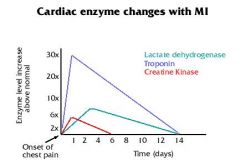
Elevated enzymes after MI "Time to CALl 911":
From first to appear to last: Troponin CK-MB AST LDH1 |
|
|
|
Agoraphobia
|
fear of open places
|
|
|
|
Albinism = defect in _
|
Tyrosinase in melanocytes
Enzyme in nerve cells is intact |
|
|
|
murmur that decreases with valsalva
|
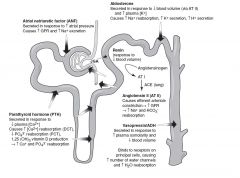
tricuspid murmur decreases with valsalva
|
|
|
|
Aldosterone:
produced by _ acts on _ to _ Increases _ Decreases _ |
Made in glomerulosa
Acts on Na/K ATPase in distal tubule + collecting duct Actively absorbs Na+ Passively secretes K+ |
|
|
|
ALL:
_ cells population characterisitic finding complication of therapy |
myeloblasts
adults auer bodies = road-shaped cytoplasmic inclusions in granulocytes + myeloblasts, esp. in M3 form Tx can release Auer rods , leading to DIC |
|
|
|
Alternative complement pathway:
Activated by 3 things Starts c/ complement proteins… |
Activated by contact c/ yeast, bacterial cell wall, endotoxin
properdin + D: C3 => C3a + C3b B => Ba + Bb C3bBb = alternative C3 convertase to C4b2a |
|
|
|
Amino terminus of a transmemnbrane protein usually encodes _
|
Signal peptide
Targets the protein, but doesn't dictate its actual fx |
|
|
|
Anaplastic small tumor of bone
Not responsive to chemo Genetic change Population Histology |
Ewing's sarcoma
t(11;22) males <15 y/o "onion skin" appearance |
|
|
|
ANCA (+) vasculitis limited to kidney
|
Primary pauci-immune crescenteric glomerulonephritis
|
|
|
|
Ang2 has what effects?
Renin_ Constriction of afferent, efferent arterioles Glomerular capillary P GFR Filtration fraction |
Decreases renin via (-) feedback
At moderate concentrations, Ang2 constricts efferent > afferent arteriole Increases efferent resisitance, glomerular capillary pressure Decreases renal blood (and plasma) flow Increases filtration fraction (GFR/renal plasma flow) |
|
|
|
Anion gap =
normal value is… |
Na - (Cl + HCO3)
normal: 12 +/- 2 |
|
|
|
Apolipoprotein A2 is a component of _
|
HDL particle
|
|
|
|
Apolipoprotein C2 does what job?
What is the consequence of deficiency? |
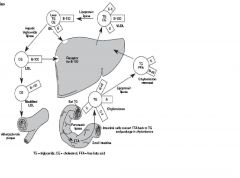
Activates lipoprotein lipase
Deficiency causes high triglycerides Lipoprotein lipase degrades triglycerides cirulating as chylomicrons + VLDLs (lipoprotein AI activates LCAT; B-100 binds LDL R; E mediates remanat (Extra) uptake) |
|
|
|
Apolipoprotein E4 has function of _
|
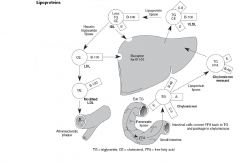
chylomicron remnant uptake into liver
|
|
|
|
ATN
Renal oxalosis (intratubular oxalate crystals visible c/ polarized light) |
Ethylene glycol ingestion
Anion gap metabolic acidosis = MUDPILES: Methanol Uremia Diabetic ketoacidosis Paraldehyde Infection Lactic acidosis Ethylene glycol Salicylates |
|
|
|
Autosomal D dz of cancer susceptibility
Mutation on chromosome 17p |
Li-Fraumeni => p53
|
|
|
|
Autosomal R disease
Giant non-functional lysosomes (dysfx of neutrophils, NK cells) bacterial + fungal infections of skin + mucous membranes |
Chediak-Higashi
Dysfx in microtubule polymerization => poor fusion of phagosome + lysosome |
|
|
|
Normal doppler ankle systolic BP > _% of brachial is normal
Peripheral artery disease rest pain usually occurs c/ ABI < _ Symptomatic tx for PVD _ Drug that prevents clots |
Normal doppler ankle systolic BP > 90% of brachial is normal
ABI < 0.4 => rest pain Symptomatic relief: Asa, cilostazol, thromboxane inhibitors Anticoagulants prevent clots |
|
|
|
B12 required for reaction:
|
removing methyl grp from N5 methyl THF --> THF
|
|
|
|
Becker MD
Inheritence Pathogenesis Dz course |
Decreased dystrophin
X-linked R May walk until age 20-25 |
|
|
|
Serous cystadenoma:
20% of ovarian tumors Can be bilateral Lined c/ fallopian-type epithelium |
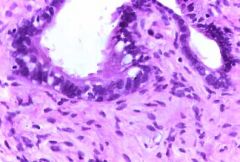
Benign endothelial ovarian tumor c/ cysts + ciliated epithelium
|
|
|
|
Benign ovarian tumor c/
multilocular cysts, non-ciliated columnar epithelium |
Mucinous cystadenoma
|
|
|
|
Benign plasma cell neoplasia
IgG or IgA <10% plasma cells in BM Can convert to multiple myeloma |
Monoclonal gammopathy
|
|
|
|
Benign tumors of eye, skin, brain are known as _
Ass'd c/ 5 genetic syndromes |
Phacomatoses
Autosomal D VHL: retino-cerebellar capuillary hemangiomatosis Ataxia-Telangiectasia Neurofibromatosis 1 Sturge-Weber: encephalotrigeminal angiomatosis Weyburn Mason |
|
|
|
Bernard-Soulier:
defect in _ due to _ lab changes |
Defect in platelet adhesion due to low GP 1b
High bleeding time No change to PT, PTT, platelet count |
|
|
|
Bilateral microabsccesses in lungs
|
Infective endocarditis of tricuspid valve
|
|
|
|
Bohr effect
|
Hgb dissociation curve shifted to R in peripheral tissue due to decreased pH
|
|
|
|
Bone mets - 2 primaries …
|
Breast > Lung
|
|
|
|
Brain mets - 2 primaries…
|
Lung > Breast
|
|
|
|
Brain tumor:
calcified, layered structures "whorling" pattern of cells c/ center that is calcified/hyalinized |
Meningioma
Psammoma bodies |
|
|
|
Bruton's agammaglobulinemia:
inheritence defect _ due to _ infections |
Bruton's agammaglobulinemia:
B for Bruton's, Boys (x-linked, affects babies after 6 mo), B cells, encapsulated Bacteria Defect in Tyr kinase gene |
|
|
|
Bullous pemphigoid:
Due to _ that binds_ of the the _ Area affected _ |
IgG against epidermal BM hemidesmosomes
Linear immunoflourescence Bullae of skin, not oral mucosa similar to but less severe than pemphigus vulgaris |
|
|
|
B-cell
most often in kids t(8;14) => c-myc Africa: jaw lesion Sporadic form: pelvis or abdomen "Starry sky" = sheets of lymphocytes interspersed c/ macrophages |
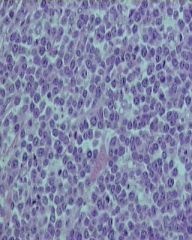
Burkitt lymphoma:
_ cells population location in body histology |
|
|
|
Ca2+ kidney stones:
precipitate in _ urine 2 drugs |
Precipitate in alkaline urine
Thiazides, K phosphate |
|
|
|
Capsular polysaccharide of H. flu is conjugated with another protein to _
|
stimuate T cell-mediated immunity,
not just IgM synthesis by plasma cells IgA is best to fight H, flu b/c it is a mucosal-surface pathogen |
|
|
|
Carboxyl terminus of a protein usually _
|
Signals for attachment of poly-A tail => mRNA stability
|
|
|
|
Carotid body measures _
|
bO2dy measures O2
|
|
|
|
Carotid sinus measures _
|
SinuS measures preSSure
|
|
|
|
Hyperglycemia, low blood amino acids, anemia, diarrhea, and weight loss of 5-15 kg.
Erythematous blisters and swelling @ areas of friction and pressure: lower abdomen, buttocks, perineum, groin. |
Glucagonoma = alpha cell tumor
very rare Tx: surgery Octreotide = somatostatin analog => inhibit glucagon release Doxorubicin, streptozotocin reduce sx progression |
|
|
|
Pneumonia:
acute pneumonia infiltrates from pyogenic vs. different causes |
"Pyrogenic=PMN, Miscellaneous=Mononuclear":
Acute pneumonia caused by Pyogenic bacteria: PMN infiltrate. Acute pneumonia caused by Miscellaneous microbes: Mononuclear infiltrate. |
|
|
|
Choriocarcinoma is caused by…
|
50% hydatiform mole (partial)
25% pregnancy 25% abortion |
|
|
|
Chronic hypersensitivity pneumonitis (peribronchial granulomas)
Type _ hypersensitivity |
Type 4
|
|
|
|
Ciliary muscle contraction is under _ control,
causes suspensatory ligaments around the lens to _ => _ lens shape makes _ change to refractive power of lens to bring _ objects into focus _ drugs prevent accomodation |
Ciliary muscle contraction is under parasymp control,
causes suspensatory ligaments around the lens to relax => rounder, more convex lens shape increases refractive power of lens to bring close objects into focus Antimuscarinic drugs prevent accomodation |
|
|
|
Clear cell is a _ type ovarian tumor
|
surface epithelial/endothelial
|
|
|
|
CLL:
cell type _ population characterisitic finding associated with _ anemia |
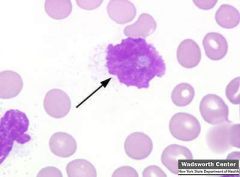
lymphocytes
elderly smudge cells on peripheral smear auto-immune hemolytic anemia, warm-Ab coomb's test staging: LOATh I: Lymphadenopathy II: Organomegaly (splenomegaly) III: Anemia IV: Thrombocytopenia |
|
|
|
Tx for septic arthritis in infant
|
nafcillin + G3 cepalosporin (cefTRIAXone or cefTAZadime)
|
|
|
|
CML
cell type _ genetic association complication of disease |
myeloid stem cell proliferation
increased neutrophils, metamyelocytes Philadelphia chromosome t(9;22) => bcr-abl hybrid can accelerate to AML => blast crisis |
|
|
|
Cocaine causes
|
decreased uptake of NE, DOPA
|
|
|
|
Collagen 4 mutattion =>
Nerve deafness Ocular disorders Also causes nephritic syndrome |
Alport's syndrome
Split BM |
|
|
|
Common variable immunodeficiency
|
Common variable immunodeficiency:
Normal #'s of B cells, but no Ab's Variable inheritence, can be acquired in 20's -30's |
|
|
|
Congenital absence of iris
Genetic basis… |
11p deletion
|
|
|
|
Congenital cardiac defect
Hydrocephalus Cleft palate |
Isotretinoin toxicity to fetus
|
|
|
|
What is the first thing to do in workup of acidotic pt c/ SBO?
|
SBO pts should be alkalotic 2/2 vomiting.
Acidosis suggests necrosis. If concern a/b perforation, do UPRIGHT AB X-RAY |
|
|
|
Congenital defect in dibasic amino acid transporter
Acidic urine Urolithiasis What disease? What aa's affected? Tx |
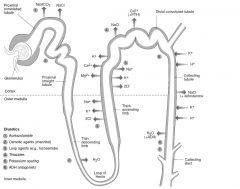
COLA: Cysteine, Ornithine, Lysine, Arginine
Cystine stones - radiolucent to faintly radiopaque Tx - acetazolamide, bicarb to alkalinize the urine |
COLA
|
|
|
Congential syphilis:
Musculoskeletal_ Skin_ Cardiac_ Neuro_ |
Saber shins, Hutchinson's incisors
Interstitial keratitis, bullous lesions of palms + soles Congenital heart defect 8th nerve deafness |
|
|
|
COPD consists of..
|
Asthma, bronchitis, emphysema
|
|
|
|
Cortisol inhibits the responses of 3 tissues to insulin …
|
Liver, muscle, adipose
|
|
|
|
Courvoiser's sign:
Painless jaundice Palpable gallbaldder What population is this esp. concerning in? |
Pancreatic adenocarcinoma
Elderly black men c/ DM |
|
|
|
Crescendo-decrescendo systolic ejection murmur
Weak, delayed carotid upstroke Paradoxically split S2 Dz course Dx Tx |
Aortic stenosis
Mostly elderly Unicuspid/bicupsid valves cause earlier dz Pulsus parvus et tardus = weak, delayed carotid upstroke Complications: ARC = Angina, Syncope, CHF Once pt is symptomatic, dz progresses from Angina -> Syncope -> CHF in ~ 5 yrs Dx: Echo Tx: balloon valvuoplasty can bridge to valve replacement |
|
|
|
Cretinism:
Cause Signs/sx |
Low dietary iodine > defect in T4 or thyroid formation
Pot-belly c/ outie, pale, puffy face + tongue |
|
|
|
Crypt abscesses = small focal collections of inflammatory cells + necrosis in colon
|
Ulcerative colitis
|
|
|
|
Hyperglycemia + migratory necrotizing skin erythema
What is the dz? Ass'd c/ what genetic dz? |
Glucagonoma = alpha cell tumor
MEN1 (pituitary adenoma, pancreatic islet cell tumors, parathyroid hyperplasia) |
|
|
|
Cyanotic cengen heart defects
|
Persistant truncus arteriosus
Transposition of great vessels Tetrology of Fallot Anomalous venous return |
|
|
|
Cyanotic heart diseases =
_ side to _ side Name 5 |
R to L
Truncus arteriosus: increased pulm vascularity Transposition of great vessels: #1 in neonate. need septal defect or PDA. PGE1 -> surgery Tricuspid atresia: also transposition in 30% Tetrology of fallot: PROVe. #1 in kids. PGE1 -> surgery Total anomalous pulm venous return |
|
|
|
Degeneration or loss of elasticity in basilar membrane in first few mm of basal end of the cochlea
Disease Caused by Affects conduction through _ |
Presbycusis = progressive loss of sensitvity to high-frequency sounds
Age-related Affects bone + air conduction |
|
|
|
Dermatomyositis:
pathogenesis presentation (2 main sx) |
CD8 attack on muscle fibers => progressive symmetric proximal muscle weakness c/ inflammation on biopsy
Rash on face, shoulders, back High CK, aldolase (+) ANA, anti-Jo-1 increased risk of malignancy |
|
|
|
diastolic knock (loud low frequency noise)
|
constrictive pericarditis
|
|
|
|
Diastolic murmur c/ "waterhammer pulse", "pistol shots" in femoral artery
|
Aortic regurgitation
|
|
|
|
Diastolic murmurs: 4 total
|
Regurgitant: aortic + pulmonic regurgitation
Venticular filling: mitral + tricuspid stenosis |
|
|
|
diastolic rumble + opening snap
dyspnea, orthopnea, PND severe cases: endocarditis, arrhythmia what dx? #1 cause is… Tx for arrhythmia is (2 drugs) Tx for severe dz (2 options) |
mitral stenosis
~20 yrs s/p rheumatic fever increased L atrial P => pulm edema, dyspnea anti-arrhythmic: digoxin, beta blocker Severe dz => mitral balloon valvotomy, valve replacement |
|
|
|
bacterial meningitis in baby 1-3 months old
3 possible organisms empiric tx is no rash, assume _ or _ If no rash AND baby has subdural effisopm on CT, assume ... If _, then treat contacts c/ _ if petichial rash, assume... |
Pneumococcus => no rash
H flu => no rash +/- subdural effusion (no special tx necessary) Meningococcus => petichial rash. rifampin for contacts Tx: IV vanc + ceftriaxone or cefotaxime |
|
|
|
Tx for myoclonus is....
|
valproic acid
clonazepam |
|
|
|
DiGeorge:
Due to gene deletion_ Defect in _ 3 body parts affected Ass'd c/ _ congenital anomaly 2 common type of infection _ |
DiGeorge:
22q11 deletion 3rd, 4th pharyngeal pouches Thymus, parathyroid, posterior aortic arch +/- truncus arteriosus Viral + fungal infections |
|
|
|
DM proliferative retinopathy is due to...
|
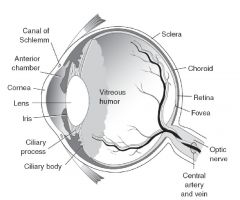
Neovascularization
|
|
|
|
Drug-induced interstitial nephritis: presentation
|
Fever, rash, + hematuria 2 wks after starting a new medication
|
|
|
|
Drugs that induce BM supression
|
Chloramphenicol (abx for meningitis)
Benzene NSAIDS Gancyclovir (CMV, esp. retinitis) Zidovudine (AZT) |
|
|
|
Drugs used in glaucoma to decrease aqueous humor production
|
beta adrenergic drugs
|
|
|
|
Drugs used in glaucoma to increase aqueous humor outflow
|
alpha adrenergic druugs
|
|
|
|
Duchenne MD:
Inheritence CPK Physical signs |
AD
Absent dystophin CPK increases, then decreases Calk pseudohypertrophy, pelvic girdle weakness, lordosis, protuberent belly possible cardiac involvement death in 2nd decade |
|
|
|
EBV is associated c/ 3 cancers…
|
1. Burkitt's lymphpoma
2. B cell lymphoma 3. Nasopharyngeal carcinoma |
|
|
|
Ehler's Danlos:
Enzyme deficiency Inheritence Presentation |
Lysyl oxidase deficiency
Abnormal collagen, elastin Autosomal D Stretchy skin, sprains, joint dislocations Vascular bleeding |
|
|
|
Elderly cardiac exam:
Pulse P Mumur Intensity HR Heart size |
Wide pulse P
Systolic mumur Increased intensity of S1 Cardiomegaly Sinus tachycardia A fib Means-Lerman scratch = high pitched sounds in pulmonic area that mimic friction rub |
|
|
|
Elevated _ leads to MR, subluxation of lens
|
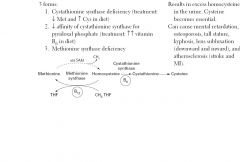
homocysteine
Homocyteinuria |
|
|
|
Encephalotrigeminal angiomatosis
Seizures Port-Wine stain |
Sturge-Weber
1. Seizures 2. Wine stain |
|
|
|
Endocarditis ass'd c/ chronic dz:
Vegetations tend to be located at.... and look like ... 4 RFs |
Thrombotic, due to platelet + fibrin deposits => vegetations symmetric @ line of valve closure
RF's: hypercoagulability adenocarcinoma(mucin-producing) SLE Trauma (e.g. catheter) mitral>aortic>tricuspid>pulmonary |
|
|
|
Endometrial hyperplasia is ass'd c/ ovarian tumor _
|
Granulosa cell tumor (secretes estrogen)
|
|
|
|
Endothelial ovarian tumor
Nests of transitional epithelium in stroma |
Brenner = Benign = looks like Bladder
|
|
|
|
Factor 5 leiden = resistance to _ which inactivates _ and _
Results in _ |
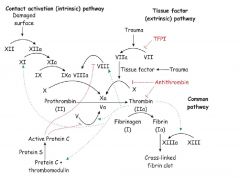
Resistance to activated protein kinase C, which inactivates factors 5a, 8a
Hypercoagulability (anti-thrombin 3 inactivates thrombin/2, 9a, 10a, 11a) |
|
|
|
Factor 5a converts _ to _
|
Prothrombin (2) to Thrombin (2a)
|
|
|
|
Fanconi syn:
Defect in _ Ass'd c/ disease _ Electrolyte prob _ Acid/Base prob_ |
Defect in renal tubules
Ass'd c/ rickets, osteomalacia Low K+ Metabolic acidosis |
|
|
|
Flask-shaped ulcers that extend into the submucosa
|
amebiasis - Entamoeba histolytica
UC ulcers only extend through mucosa |
|
|
|
Folate absorbed in
|
jejeunum
|
|
|
|
G6PD-defic ass'd hemolysis is associated c/ drugs…
|
AAA:
Antibiotic (eg: sufamethoxazole) Antimalarial (eg: primaquine) Antipyretics (eg: acetanilid, but not aspirin or acetaminophen) |
|
|
|
colorectal cancer + osseous/soft tissue tumors + retinal hyperplasia
tumors are exostoses (bony projections capped c/ cartilage), sebaceous cysts, dermoid tumors, colon polyps |
Gardner's syndrome =
form of familial adenomatous polyposis |
|
|
|
Gaucher's disesae
|
β Glucocerebrosidase deficiency
AR Hepatosplenomegaly, aseptic necrosis of femur, bone crises, Guacher’s cells = macrophage |
|
|
|
Glanzman's thrombasthenia:
defect in _ due to _ |
Defect in platelet aggregation due to low GP 2b3a
high bleeding time no change to PT, PTT, platelet count |
|
|
|
Glycogen storage diseases
Inheritence Mneumonic Deficiencies + main organ affected |
AR
Very Poor Carb Metabolism 1. von Gierke: Glucose-6-phosphatase, liver 2. Pompe's: alpha 1-4-glucosidase, heart 3. Cori's: debranching alpha 1,6 glucosidase 4. McArdle: glycogen phosphorylase in skel muscle |
|
|
|
Gower's maneuver
|
Duchenne's: use of pt's arms to help legs pick self off floor
|
|
|
|
Granulomatous vasculitis
Eosinophilia (+) ANCA Affects 5 areas of body… Often seen in pts c/ hx of _ |
Chrug-Strauss syndrome = PAVE:
P-ANCA Asthma Vasculitis Eosinophilia Kidney, lung, heart, skin, nerves Often seen in atopic pts |
|
|
|
Hairs in nostrils filter out particles larger than _
|
10 microns
|
|
|
|
Haldane effect
|
In lungs, oxygenation of Hgb promoted the dissociation of CO2.
(5% of circulating CO2 is boung to Hgb; vast majority is transported as HCO3-) |
|
|
|
Hand-Schuller-Christian
|
Chronic progressive histiocytosis
Diabetes insipidus, exopthalmos, skull lesions, lytic bone lesions |
|
|
|
Having pt lay down to listen for murmur generally makes it _ in intensity
|
Similar to taking deep breath: increases blood to R heart, intensity of a R-sided murmur
|
|
|
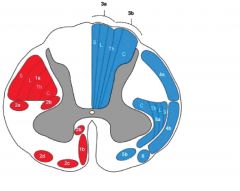
Crescendo-decrescendo systolic murmur transmitted to axilla
"small + weak" pulse Congenital or Degenerative calcification |

Aortic stenosis
Crescendo-decrescendo systolic murmur Transmitted to axilla Pulsus parvus et tardus = "small + weak" pulse LV >> aortic P in systole |
|
|
|
Holosystolic, transmitted to axilla
High-pitched "blowing" |
Mitral regurgitation
Holosystolic, transmitted to axilla High-pitched "blowing" 2/2: MI (papillary muscle) Acute rheumatic fever Endocarditis |
|
|
|
Heart sound:
Rheumatic heart disease A fib |
Mitral stenosis
Diastolic rumble Loudest in early + late diastole (atrial systole) +/- opening snap + loud S1 |
|
|
|
Heart sound:
young female or Marfan's How do supine/standing/anxiety change it? |
Mitral valve prolapse
#1 valvular lesion Mid-systolic click + late systolic mumur Heard @ apex Due to myxomatous degeneration in normal person = excess of dermatan sulfate in valve. Standing: lower preload, less blood in LV, closer to S1 Laying down: higher preload, closer to S2 Anxiety: higher HR, less blood inLV, closer to S1 |
|
|
|
Heberden's nodes
|
Osteoarthritis: DIP swelling due to osteophytes
|
|
|
|
Pt c/: DM, hypogonadism, MCP arthropathy, HF, skin discoloration, CHF, hepatomegaly
Fasting transferrin > 45% Disease Inheritence RF Tx Complications |
Hemochromatosis:
Hemosiderin accumulation Autosomal R HLA A3 Cirrhosis, cardiac failure, hyperpigmentation, DM due to chronic pancreatitis Tx: Deferoxamine, phlebotomy Risk of HCC |
|
|
|
Hemophilia A/B
lab change |
increased PTT
|
|
|
|
Hypersensitivity vasculitis ass'd c/ hemorrhagic urticaria and URIs
Purpura (lesions of same age), arthralgia, intestinal hemorrhage #1 hypersensitivity vasculitis in kids |
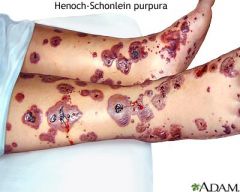
Henoch-Schlonlein purpura:
3 main sx |
|
|
|
20-40 y/o F
insidious onset of minor bleeding, petechiae, hematuria no splenomegaly Dz _ Ass'd c/ conditions _ Tx _ |
Chronic ITP
IgG against platelets Female: Male 3:1 Diagnosis of exclusion Ass'd c/ lymphoma, leukemia, SLE, HIV, HCV Unlikely to remit spontaneously (unlike acute ITP, more common in children) Tx if platelets < 20,000 Corticosteroids, IVIG, splenectomy New: Anti-D (Rh)-Ig, rituximab |
|
|
|
2-6 y/o c/ recent virus
minor bleeding, easy bruising, petechiae, hematuria no splenomegaly Dz Dx Tx #1 immunologic disorder in women of childbearing age |
Acute ITP
IgG against platelets High platelets, megakaryocytes in marrow Dx of exclusion (platelet-ass'd Ab test not good) Tx: children often remit spontaneously no tx if platelets > 20,000 tx: corticosteroids, high-dose gamma globulin (IVIG), splenectomy Newer: Anti-D IgG, rituximab = anti-CD20 monoclonal Ab pregnant pt => thrombocytopenia can occur in fetus |
|
|
|
Hgb F is seen in infants + _
|
Thalassemia major
|
|
|
|
Hgb-O2 dissociation: L shift ...
R shift… |
L shift => Loads O2 in Lungs
R shift => Releases O2 from Hgb |
|
|
|
High-output cardiac failure
i.e. dilated cardiomyopathy _+ neuro changes |
Wet beri-beri (thiamine/B1 deficiency)
|
|
|
|
High-pitched early diastolic murmur or
Rumbling diastolic murmur @ apex or Crescendo-decrescendo systolic murmur @ L sternal border |
Aortic regurgitation
|
|
|
|
Histiocytosis X
cell type _ population RF |
Langerhan's cells from monocyte lineage infiltrate the lung
young adults RF = smoking |
|
|
|
Histology of Grave's
|
Small follices, little colloid
|
|
|
|
LABOR:
1. Latent phase: up to _ hrs in primi, _ hrs in multiparous. to _ cm Active phase: at least _ cm/hr in primi, _ cm/hr in multi 2. Complete dilation to delivery: _ min to _ hrs in primi, _ min in multi |
LABOR:
1. Latent phase: up to 20 hrs in primi, 14 hrs in multiparous. to 2-3 cm Active phase: at least 1 cm/hr in primi, 1.2 cm/hr in multi 2. Complete dilation to delivery: 30 min to 3 hrs in primi, 5-30 min in multi |
|
|
|
How do TMP-SMX and warfarin interact? (3 ways)
|
1. TMP-SMX displaces warfarin from plasma proteins
Both similarly metabolized by liver, so increases level of both TMP-SMX kills intestinal bacteria that produce vit K |
|
|
|
How does ESR work?
|
(-) -charged acute phase proteins cause RBCs to adhere => rolleux
|
|
|
|
HPV strains _, _ are ass'd c/ carcinoma esp. in region of _.
_ = dysplastic cervical cells |
HPV 16,18
Often sq cells @ transition zone Koilocytes = dysplastic cells, not yet carcinoma |
|
|
|
Human herpes virus 8 is associated c/ cancer )_
|
Kaposi sarcoma
|
|
|
|
Hydatiform mole:
Occur when _ 2 types _% are malignant RFs |
Result of fertilization by multiple sperm
Complete = no embryo or placenta, 46XX paternal only Partial = triploid 20% malignant => 50% of choriocarcinoma RFs: large uterus, older |
|
|
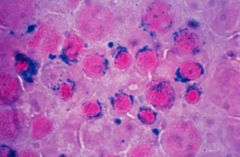
Hypochromic microcytic anemia c/ high iron, % sat, ferritin; low TIBC
What dz? Peripheral smear shows… 4 main causes |
Sideroblastic anemia
Ringed sideroblasts Iron overload => Pappenheimer bodies 1. Heavy metals: lead, zinc 2. EtOH, INH, chloramphenicol 3. B6 or Cu deficiency 4. ALA synthase deficiency (X-linked) INH inhibits long-chain enoyl reductase => prevents mycolic acid synthesis Chloramphenicol binds ribosomal 50S, inhibits peptidyl transferase. Static ALA synthase + B6 do rate limiting step of porphyrin synthesis: Glycine + Succinyl CoA => Aminolevulinic acid |
|
|
|
Hypovolemia tends to cause metabolic _ mechanism?
|
metabolic alkalosis
renal compensation for volume => reabsorption of Na + HCO3 in proximal tubule |
|
|
|
Pt c/ anaphylactic transfusion rxn
hx of chronic sinutsitis, pneumonia, Giardia Disease Inheritance |
IgA deficiency
#1 congenital immunodeficiency Autosomal inheritence Sinusitis, pneumonia, GI esp. Giardia |
|
|
|
In metabolic acidosis, anion gap falls _ ,Eq/L for every 1 g/dL drop in albumin
(normal albumin 3.5-5.5 g/dL) |
2.6 mEq/L
(fall in Ca2+, Mg2+ can also increase gap) |
|
|
|
Infant c/ cataracts, MR, hepatomegaly, jaundice, FTT
Disease Inheritence Mechanism |
Glactosemia:
AR more common in Indians 2 enzyme defects possible Uridyltransferase = more common (galactose-1-P --> UDP galactose) Galactokinase = rare (galactose --> galactose-1-P) Tx = decrease dietary galactose |
|
|
|
Intraepidermal bullae involving oral mucosa + skin
IgG against cell surface desmosomes immunoflouresence throughout epidermis |
Pemphigus vulgaris
potentially fatal |
|
|
|
Iron absorbed in
|
duodenum
|
|
|
|
ITP:
pathogenesis labs type _ hypersensitivity |
anti-platelet Ab's
low platelets high megakaryocyes high bleeding time normal Pt, PTT type 2 hypersensitivity can be secondary to SLE, HIV, hemolytic anemia (in kids, usually self-limited, after viral infection) |
|
|
|
IUGR, MR, FTT
Short sternum, small pelvis, low ears Rocker-bottom feet Horseshoe kidney Cardiac dz, intestinal defects Death <1 yr 4x more common than Trisomy 13 |
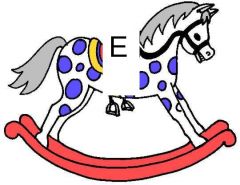
Edwards = trisomy Eighteen
4x more common than Trisomy 13 |
|
|
|
Korsakoff's:
_ amnesia due to deficiency in _, which is needed for _ reactions Lesion in _ |
Anterograde amnesia due to thiamine deficiency => bilateral destruction of mammilary bodies
thiamine required for oxidative phosphorylation of alpha-ketoacids |
|
|
|
L-> R shunt c/ wide and fixed split S2, systolic ejection murmur @ upper L sternal border
dz ass'd c/ 3 syndromes... _ defects present in childhood _ defects present in adulthood |
ASD
Ostium primum: early childhood, fatigue c/ exertion Ostium secumdum: late childhood, early adulthood Holt-Oram = ASD, (-) radii, 1st-deg heart block Fetal alcohol syn Down's |
|
|
|
osteomalacia, rickets ->
what lab changes? Ca2+, vit D, P, PTH |
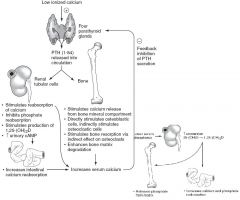
Low Ca2+,vit D
High PTH (in reponse) => Low P |
|
|
|
Large testicular mass in young boy.
High AFP |
Yolk sac tumor
Aggressive Sacrococcygeal area of young kids |
|
|
|
Liver mets - 5 primaries …
|
"Cancer Sometimes Penetrates Benign Liver"
Colon > Stomach > Pancreas > Breast > Lung |
|
|
|
Locus heterogeneity
|
Same phenotype occurs by mutations @ 2 different loci
|
|
|
|
Lung cancer:
Smoker Keratin pearls, intracellular bridges PTHrP Arises from _ => location in _ |
Sq carcinoma
Arises from bronchus => centrally located tumor |
|
|
|
Lung cancers s/ smoking hx (3)
and how to tell them apart |
AdenoCA: peripheral, weakly ass'd c/ smoking
Carcinoid: carcinoid syn suggests mets Benign: adenoma, leiomyoma, hamartoma |
|
|
|
Tx for parkinson-like sx in schizophrenics: 2 drug types
|
Anticholinergics: benetropine, trihextphenidyl
Antihistamines: diphenhydramine Acute dystonia: anticholinergics Akathesia: propranolol > benzos, anticholinergics Dyskinesia: anticholinergic or amantadine = dopamine agonist Tardive dyskinesia: anticholinergic (may initally worsen sx) |
|
|
|
Malignancies in kids: most common, most common solid, most common solid outside CNS
|
ALL (CALLA Ag = CD10, in 80% of ALL, some CML)
Brain tumors Neuroblastoma |
|
|
|
Malignancy ass'd c/ fever (non-infectious)
|
Hodgkin's dz:
Fever, night sweats, wt loss, mediastinal lymphadenopathy Young > Elderly, M>F Reed-Sternberg cells = CD15, CD30 Nodular sclerosing ~70%, F>M, young adults, collagen banding, lacunar cells, few RS cells Mixed cellularity ~25%, many RS cells Lymphocyte-predominant ~5%, young males, few RS cells |
|
|
|
Malignant ovarian germ cell tumor
Analagous to seminoma What tumor, tx? |
Dysgerminoma
Radiotherapy |
|
|
|
Malignant plasma cell neoplasia
IgM, eosinophilic plasma "flame cells" hypervisosity What dz? What population? |
Waldenstrom's macroglobulinemia
NO bone lesions Men >50 y/o |
|
|
|
Maple syrup urine dz:
Unable to break down _, e.g. _ |
Unable to break down branched-chain amino acids, e.g. isoleucine
|
|
|
|
Marfan's:
Mutation of gene for _ on chromosome _ Inheritence_ Triad_ |
Fibrillin mutation on chromosome 15
AD 1. Tall build c/ hyper-extensible joints 2. Subluxation of lens 3. CV defects: cystic medial necrosis, disecting AA, valvular prolapse |
|
|
|
MCV > 100:
2 common causes 1. Deficiencies 2. Drugs |
1. Megaloblastic, due to B12/folate deficiency => block DNA synthesis
B12: high methylmalonic acid (MMA), homocysteine Folate: normal MMA, high homocysteine 2. Drugs that interfere c/ DNA synthesis: AZT, sulfas |
|
|
|
MCV <80 + hypochromic anemia
|
#1 = Iron deficiency (low iron, high TIBC, low ferritin, spoon nails, premature babies, menorrhagic if female, ulcers if <50 y/o, CRC if >50 y/o)
Lead poisoning (basophilic stippling => persistant ribosomes) Sideroblastic anemias Thalassemias (target cells present) Late anemia of chronic disease (low TIBC, high ferritin) |
|
|
|
Medial calcific stenosis of small/medium arteries
"gooseneck lumps" aysmptomatic What disease? Population? Arteries affected? |
Munckeberg's arterioscerosis
Involves media; not intima so not obstructive Radial + ulnar arteries >50 y/o |
|
|
|
Megaloblastic anemia: Ab's against _
|
parietal cells
|
|
|
|
Meig's syndrome = ascites, hydrothorax, ovarian tumor_
|
Fibroma = solid tumor c/ spindle-shaped fibroblasts
|
|
|
|
Menstrual cycle:
_ acts as (+) feedback to cause LH surge => ovulation |
17-β-estradiol peak in absence of progesterone acts via (+) feedback to cause LH surge (~ 24 hrs after estradiol surge) =>
ovulation ~12 hrs after that |
|
|
|
Menstrual cycle:
On day 25, _ causes progesterone/estrogen levels to _, which leads to _ in endometrial cells |
Continued low LH (after peak on ~day 14) cause luteolysis on day ~25 = death + regression of corpus luteum
Causes drop in progesterone, estrogen Low progesterone => destabilizes lysosomes of endometrial cells => inflammation => menstruation 3 days later |
|
|
|
Menstrual cycle:
corpus luteum secretes estrogen and progesterone, which do what? |
Inhibits ability of estrogen to cause endometrial proliferation
Progesterone causes differentiation of previously thickened endometrium into secretory form |
|
|
|
Metabolic acidosis can be induced by diuretics…
|
K-sparing (spironolactone)
Amiloride/Triamterene (Na+ channel blocker in collecting duct) |
|
|
|
Metabolic alkalosis can be induced by 2 diuretics
|
Loops
Thiazides |
|
|
|
Metabolic alkalosis can be induced by 2 electrolyte imbalance of _
|
1. Hypokalemia: causes intracellualr shift of H+
2. Hypercalcemia, milk-alkali syn: causes renal H+ loss |
|
|
|
Mg -NH3-P stones
Dx Tx |
Radiopaque
1. Urine acidification 2. Abx to kill staph, klebsiella, proteus |
|
|
|
Microcephaly
Cleft lip/palate Polydactyly Cardiac dextroposition, septal defects |
Patau = trisomy 13
|
|
|
|
Microcephaly
Rocker-bottom feet Polydactyly Cleft palate |
Trisomy 13 = Patau syndrome = 47 XX, +13
|
|
|
|
Middle-aged ♂ c/ hepatosplenomegaly
Pancytopenia B cells c/ filamentous projections |
Hairy cell leukemia
|
|
|
|
Middle-aged woman c/ esophageal webs, atrophic glossitis
disease etiology cancer risk |
Plummer-Vinson
Iron-deficient anemia risk of sq carcinoma of esophagus |
|
|
|
Migratory polyarthritis
Erythema Subcutaneous nodules Chorea Carditis |
Acute rheumatic fever
5 Jones criteria 1-4 wks s/p grp A β-hemolytic strep tonsillitis Arthritis + fever may last 2-3 wks |
|
|
|
follicular conjunctivitis
neovascularization in cornea runny nose Dz Dx Tx |
Trachoma = Chlamydia A-C
pannus = neovascularization in cornea Dx: giemsa stain of conjunctival scrapings Tx: PO tetracycline or erythromycin |
|
|
|
Young man c/ recent hx upper respiratory or GI infection
Episodic gross hematuria or persistent microscopic hematuria Normal C3 Dz Tx |
IgA nephropathy = Berger's
May be seen in Henoch-Schonlein purpura "Active urine sediment" Mesangial deposits on IF, EM Tx: glucocorticoids for select pts. #1 nephritic syndrome ACE-I if proteinuria present 20% progress to ESRD |
|
|
|
DIC:
7 causes (remember mnemonic) |
"STOP Making New Thrombi": Sepsis c/gram (-)
Trauma Obstetric (e.g. retained material) = #1 cause Pancreatitis (acute) Malignancy Nephrotic syn Transfusion Coag cascade activated -> microthrombi, consumes platelets/fibrin/coag factors. High PT, aPTT, D dimer = fibrin split products. Low platelets, factors 5 + 8. Helmet cells + Schistocytes |
|
|
|
Non-Hodgkin's lymphoma
85% are _-cell origin #1 type is _ _ is necessary for NHL diagnosis Staging is based on _ Tx is based on _ |
Follicular = small cleaved cell. t(14;18) => bcl-2 (blocks apoptosis)
Indolent waxing/waning, non-painful lymphadenopathy, hard to cure NLH's tend to affect younger adults, no hypergammaglobiulinemia, multiple nodes, non-contiguous spread, RF's = HIV, immunosupression Dx: excisional LN bx + CSF exam if HIV, neuro sx, primary CNS lymphoma Staging based on # of LN's, whether dz crosses diaphragm Tx based on histo classification |
|
|
|
MR
Airway obstruction “Gargoylism” Corneal clouding Disease Mechanism Inheritence |

Hurler's
(mucopolysaccharidosis) Heparan/dermatan sulfate accum. Heptosplenomegaly Ugly facies = gargoylism Recessive (AR) L-iduronidase deficiency (alpha) Eyes (corneal clouding) Retarded Short/ Stubby fingers |
|
|
|
Multiple bilateral ovarian _ -type cysts
|
Theca-lutein cyst
Ass'd c/ gonadotropin stimulation, choriocarcinoma, hydatiform mole |
|
|
|
Neoplasm associated with amyloidosis
|
Multiple myeloma => tissue depoits of AL amyloid
|
|
|
|
Neoplasm associated with increased osteoclast-activating factor
|
Multiple myeloma => "punched out" skull, bone lesions
|
|
|
|
Nephritic syn:
common in kids periorbital + peripheral edema LM: lumpy-bumpy glomeruli EM: subEPIthelial humps IF: granular pattern |
Post-strep glomerulonephritis = diffuse proliferative nephritic syn
(SLE = sub-epithelial deposits + nephrotic syndrome) |
|
|
|
Nephrotic stn
LM: diffuse capillary + BM thickening IF: granular pattern EM: "spike + dome" |
Membranous glomerulonephritis
|
|
|
|
Nephrotic syn ass'd c/ multiple myeloma, TB, RA
|
amyloidosis
|
|
|
|
Nephrotic syn:
insidious onset no immune complexes loss of foot processes good prognosis |
Minimal change dz
responds well to steroids #1 childhood nephrotic syndrome |
|
|
|
Nephrotic syn:
LM: normal glomeruli EM: foot process effacement |
Minimal change dz
responds well to steroids #1 childhood nephrotic syndrome |
|
|
|
Membranoproliferative glomerulonephritis
Nephritic syndrome Sub-ENDOthelial humps on EM in "tram track" pattern Young adults Poor prognosis: slowly progresses to renal failure |
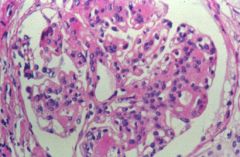
Nephritic syndrome c/
HTN + hematuria + azotemia (high BUN, Cr) |
|
|
|
Neurofibromatosis 2: Mutation in _ (_-type gene) on chromosome _
2 signs increased risk of 2 things |
Mutation in NF2 tumor-supressor gene on chromosome 22
AD Bilateral acoustic neuromas Risk of meningiomas, pheochromocytomas 10% of NF cases |
|
|
|
Newborn c/
Hypoplastic thumbs, radii Aplastic anemia Cafe au lait spots Systemic acidosis Urine: high P, aa's, glycosuria Blood: low P |
Fanconi anemia
Autosomal R (can be acquired) Bone marrow DNA = more susceptible to alkylating agents Low absorbtion in prox renal tubule of P, glucose, aa's, bicarb |
|
|
|
40-50 y/o pt c/ painless testicular enlargement
+/- beta HCG elevation Workup Tx |
Seminoma
Presents @ 15-35 y/o Workup: testicular US, CXR + ab/pelvic CT to r/o mets Beta HCG high in 10% of seminomas, all choriocarcinomas Tx: seminomas are radiosensitive, respond to chemo. surgery = default for testicular cancer |
|
|
|
Non-germ cell testicular tumor (
Little to no hormone production |
Sertoli cell
(Leydig makes androgenes, estrogens, corticosteroids) |
|
|
|
Non-tender macular patches on palms, soles
Hematuria Fever, chills Disease? Etiology? |
Acute infective endocarditis
Janeway lesions Staph aureus, Strep |
|
|
|
Osteitis deformans = Paget's
Due to _ Presentation _ Lab values _ |
Abnl osteoclastic + osteoblastic activity
Long bone chalkstick fractures Softened, enlarged bone High Alk phos (heat-labile, unlike hepatic Alk Phos) Normal Ca2+, P, PTH High output CHF due to vascularity of lesions 3:2 M:F |
|
|
|
Osteitis fibrosa cystica:
Due to _ High _ Low _ Look like_ |
Due to hyperparathyroidism
High Ca2+, Alk phos Low P "brown tumors" = cystic spaces lined by fobrous stroma +/- blood |
|
|
|
Osteopetrosis
definition labs |
AKA marble bone dz
Abnl osteoclast fx => thick, dense, painful bones Normal Ca2+, P, Alk phos Anemia due to BM displacement |
|
|
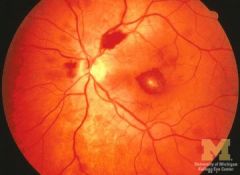
Oval retinal hemorrhages c/ pale center
Red tender lesions on finger/toe pulps Low fever What disease? Etiology RF Tx |

Subacute endocarditis
Roth spots, Osler nodes Strep viridans, Enterococcus, Staph epi (prosthetic valves), Candida, Aspergillus Tx: empiric IV vancomycin + (ceftriaxone or gentamycin) |
|
|
|
Ovarian tumor c/ glandular cells
(cells resemble uterine endometrial adenocarcinoma) |
Endometriod (surface epithelial type ovarian tumor)
|
|
|
|
p53 promotes apoptosis in mutated cells by increasing synthesis of _ gene product
|
bax = apoptosis gene
|
|
|
|
Palpate for heart apex @
|
5th IC space, midclavicular line
|
|
|
|
Pancarditis (infectious cause)
|
Rheumatic fever
Typically 1-5 wks s/p Step pharyngitis Migratory polyarthritis of large joints Erythema marginatum (rash) is esp. common in "bathing suit" distribution May have pancarditis = inflamm of all layers of heart Mitral valve most commonly affected > both mitral + aortic Sequelae = mitral stenosis, aortic regurgitation, mitral regurgitation Myocarditis can cause ventricular dilatation, CHF |
|
|
|
Pansystolic murmur loudest @ apex
|
Mitral regurgitation
|
|
|
|
Pansystolic murmurs
_ c/ inspiration |
Mitral regurgitation
Tricuspid regurgitation R side increases c/ inspiration L side decreases c/ inspiration may obscure S1 + S2 |
|
|
|
Paraneoplastic syn:
Diarrhea Low K+ Achlorohydria |
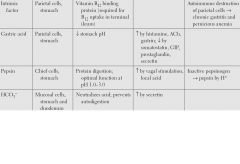
VIP (Sq lung cancer)
|
|
|
|
Paroxysmal nocturnal hemioglobinuria:
pathogenesis Labs: blood, urine |
Intravascular hemolysis due to membrane defect
RBCs sensitive to lytic activity of complement high urine hemosiderin |
|
|
|
Particles of size _ may reach bronchial walls,moved back up by mucociliary elevator
|
2-10 microns in diameter
|
|
|
|
Pathway of sperm start to finish
|
"SEVEn-UP":
Seminiferous tubules (production) Epididymis (storage) Vas deferens Ejaculatory ducts (nothing) Urethra Penis |
|
|
|
PDE5 (famous for sildenafil) is found in 5 tissue/cell types…
|
Vascular smooth muscle
Visceral smooth muscle Skeletal muscle Platelets Corpus cavernosum smooth muscle degrades cGMP => smooth muscle relaxation, inflow of blood |
|
|
|
persistant truncus arteriosus results from…
|
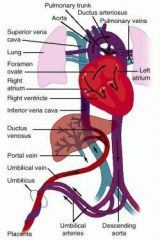
Failure of truncus arteriosus to separate into pulmonary artery and aorta
|
|
|
|
Phenylketonuria:
3 main signs/sx Enzyme deficiency inheritence |
1. Hypopigmentation (skin, eyes) 2. Musty odor
3. MR Autosomal R Defect in phenylalanine hydroxylase (Phenylalanine --> Tyr --> dopa --> dopamine --> NE --> E). Tyr becomes an essential AA. |
|
|
|
Pheochromocytoma:
what impact on blood sugar? |
Hyperglycemia
Hyperglycosurai |
|
|
|
Platelet-derived growth factor:
made by (2)… Job… |
Made by platelets, endothelial cells
Proliferation of vascular smooth muscle |
|
|
|
Pleiomorphic adenoma commonly affects the _
Challenge to therapy |
Parotid gland
Benign lesion c/ poorly-defined "fingers" extending into gland that increase risk of recurrence |
|
|
|
Polyarthritis, Erythema, Subcutaneous nodules, Chorea, Carditis
|
Major Jones Criteria for Acute Rheumatic Fever
1-4 wks after Grp 1 β-hemolytic strep tonsillitis |
|
|
|
Polyhydramnios is seen with..
2 signs of this dz in newborn |
duodenal atresia
newborn has vomiting, "double bubble" on x-ray |
|
|
|
Lady >50 y/o has pain and stiffness in shoulder, pelvic girdle
Difficulty getting out of a chair, lifting arms above head No weakness +/- Fever, high ESR, anemia Dz Tx Increased risk of _ |
Pain/stiffness in shoulders, hips
Fever, malaise, wt loss NO weakness Ass'd c/ temporal arteritis tx = LOW-DOSE PREDNISONE (10-20 mg/day) |
|
|
|
Polyostotic fibrous dysplasia:
Definition Albrights triad |
Fibroblasts + collagen replace bone
Albright's = multiple bone lesions, endocrine (precocious puberty), unilateral pigmented skin lesions |
|
|
|
Post-surgical thrombocytopenia:
due to… give _ tx of _ |
Due to sepsis, H2 blockers, DIC, transfusion, abx, swann-ganz
Giver DDAVP (promotes release of vWF, factor 8) if etiology is uremia, Asa, or bypass |
|
|
|
Potter's syndrome
|
malformation of ureteric bud => bilateral renal agenesis
oligohydramnios, limb + facial deformities, pulm hypoplasia |
|
|
|
Pre-eclampsia is associated with vascular problem of _. High ratio of _ to _ can result in 2 major problems…
|
Arteriolar spasm
Possibly due to high ratio of thromboxane to prostacyclin Renal vasospasm decreases GFR => increases BUN, Cr, causes proteinuria High thromboxane can also cause platelet aggregation, thrombosis, thrombocytopenia |
|
|
|
chronic hepB is treated c/ 2 drugs...
|
interferon or lamivudine
|
|
|
|
Proteins C and S inactivate _ and _
|
5a and 8a
|
|
|
|
Pruritic , purple, polygonal papules
what disease? pathogenesis: _ infiltration @ _ |
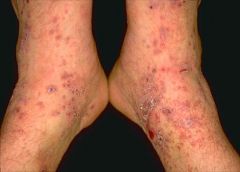
Lichen planus
Lymphocyte infiltrate @ dermo-epidermal junction |
|
|
|
Pruritic papules + vesicles
Deposits of IgA @ tips of dermal papillae What disease? Associated with _ |
Dermatitis herpetiformis
Ass'd c/ celiac sprue |
|
|
|
Pseudomyxoma peritonei is complication of ovarian tumor…
|
Mucinous cystadenocarcinoma rupture or mets
|
|
|
|
Pt c/ fever, malaise, dark urine, periorbital edema
increased ASO titer decreased serum complement |
Post-step gomerulonephritis
#1 nephritic syndrome |
|
|
|
Pt c/ hyaline microthrombi in small vessels
Helmet cells, schistocytes Neuro changes Renal insufficiency Fever What is the mnemonic for this dz? Tx |
TTP
FAT RN: Fever Anemia Thrombocytopenia (normal coag factors) Renal problems Neurologic dysfunction Tx: steroids, plasmapheresis Platelet transfusion contraindicated |
|
|
|
Pt c/ viral/fungal infections due to __. Hx of tetany, tx of truncus arteriosus
|
DiGeorge: T cells absent.
|
|
|
|
Pt c/o:
flushing cyanosis increased GI motility bronchoconstriction decreased BP R heart abnl +/- ab/rectal pain What dz? Tx? |
Carcinoid syn due to mets from carcinoid tumor
Vasoactive amines: 5HT, histamine, kinins, prostaglandins Tx = octreotide |
|
|
|
Pt has 1. Oval retinal hemorrhages c/ pale center. 2. Red, tender lesions on finger + toe pulps. 3. Low grade fever. 4. Hx abnl L-heart valves.
Dx = _ due to _ or _ Tx |
Subactute infective endocarditis
Strep viridans > Gram (-) bacilli Tx: early empiric abx - vancomycin or ceftriaxone Surgery indications = PUS RIVER: Prosthetic valve, Uncontrolled infection, Supperative complications c/ abnl conduction, Resection of mycotic aneurysm, Ineffective antimicrobial tx (e.g. vs. fungi), Valvular damage is significant, Embolization - repeated systemic, Refractory CHF or sudden onset |
|
|
|
Pt has HTN, alkalemia, low K+.
No edema |
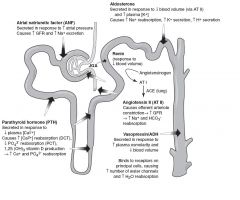
Conn's = hyperaldosteronism
may be due to adrenal adenoma Aldoserone raises Na+, gets rid of K+, H+ HIGH: total body Na+, pH, BP, ECF volume, plasma volume LOW: K+, renin, Ang 2 NO EDEMA |
|
|
|
Pt has hyperkalemia, acidemia, hypotension
|
Addison's = hypoaldosteronism
HIGH: K+, renin, Ang 2 LOW: total body Na+, pH, BP, ECF volume, plasma volume |
|
|
|
Pt has leukemia, gout, + radioLUCeNT kidney stones.
Mechanism Tx |
Uric acid stone
Urine pH < 5.5 Tx:Can pass stone <5 mm Lithotripsy (ESWL) or percut. nephrolithotomy if <3cm hydration + purine restriction CITRATE -> converted to HCO3- in liver Allopurinol = xanthine oxidase inhib = inhibits urate production) |
|
|
|
Pt has non-tender macular patches on palms, soles. High fever, chills. Hematuria.
Dx = _ due to _ or _ Early empiric IV antibiotic tx is ... |
Acute infective endocarditis
Staph aureus or Step Janeway lesions Early empiric: Gent (MSSA, GNR) + Vanc or CefTRIAXone (no MRSA) |
|
|
|
Pt has platelet/thrombin deposits on valve
|
Marantic endocarditis
Trombotic dz ass'd c/ chronic illness |
|
|
|
Pt has verrucos lesions on both sides of valve leaflets
|
SLE endocarditis
|
|
|
|
Erythema multiforme
Stevens-Johnson: sulfa drugs, anti-convulsants => fever, bullae, necrosis, high mortality HSV => most recurrent cases Immune complexes Drugs: penicillins, sulfonamides, barbiturates, NSAIDS, thiazides, phenytoin HSV, Hep A/B Strep, Mycoplasma Fungi Malignancy, Radiotx Pregnancy |
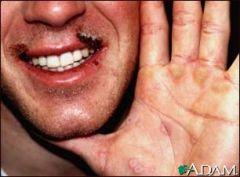
Pt takes antibiotic + develops rash:
multiple lesions of varying types - macules, paples, target lesions Ass'd c/ infections, drugs, cancer, autoimmune diseases What disease? 2 major causes (recurrent, acute) |
|
|
|
Pt c/ dyspnea on exertion, orthopnea, PND
3 possible murmurs: Decresendo blowing diastolic murmur @ L sternal border Mid-diastolic rumble Midsystolic apical murmur Wide pulse P, head bob c/ heartbeat, water-hammer pulse, femoral bruit c/ compression of femoral artery Dz Tx |
Aortic regurgitation
Causes = CREAM: Congenital Rheumatic damage Endocarditis Aortic dissection/root dilation Marfan's Tx: vasodilator = CCB or ACEI until sx bad enough to warrant valve replacement |
|
|
|
Pulsus paradoxus
|
Exaggeration of normal inspiratory fall in BP.
Pericarditis |
|
|
|
Restrictive lung dz ass'd c/ black sputum or carbon dust or finrous silicates
What type of hypersensitivity? |
Pneumoconiosis
Berylliosis = type 4 hypersensitivity T memory cells activate macrophages + NKs => toxic to Ag-bearing target cells |
|
|
|
NAACP:
Neoplasm Allergy/ Asthma Addison's disease Collagen vasc. dz: PAN, dermatomyositis Parasites: helminth, schistomia, coccidioidomycosis CSF analysis to r/o drug rxn: sulfonamides, iodides, Asa, phenytoin Image lungs, abdomen, pelvis + brain |
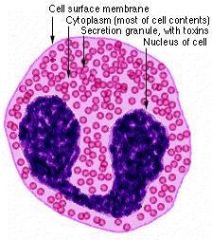
Eosinophilia = abs eosinophil count [(EBC)(% eosinophils)(0.01)] > 350
5 causes Workup |
|
|
|
Retinal microaneurysms c/ leakage => exudate, edema, hemorrhage
"cotton wool spots" Dz Tx |
DM non-proliferative retinopathy
Microaneurysms c/ leakage => exudate, edema, hemorrhage Hard protein exudates in deep retinal layer "Cotton wool spots" = microinfarcts in superficial retina Tx: laser photocoagulation tx for retinal neovascularization |
|
|
|
Retino-cerebellar capillary hemangiomatosis
|
von Hipple Lindau
HIPPEL: Hemanigoblastomas Increased renal cancer Pheochromocytoma Port-wine stains Eye dysfunction Liver, pancreas, kidney cysts |
|
|
|
Rheumatic fever affects valves _
_ type hypersensivity |
Mitral > Aortic
Type 2 hypersensitivity |
|
|
|
R-side murmurs generally _ in intensity in inspiration
|
increase (more blood entering R heart)
|
|
|
|
S3
|
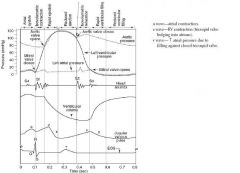
at early diastole = time of max ventricular filling
"protodiastolic gallop" - not valvular origin Due to poor compliance of LV (e.g. CHF) => vibration of chordae tenindae Normal in kids, young adults, pregnancy |
|
|
|
S4
|
at atrial contraction (so only present during sinus rhythmn
"presysolic gallop" sign of a failing LV sound of blood being forced into a stiff/hypertrophic LV |
|
|
|
Salmonella enteritis tends to involve 2 regions of GI tract…
|
Ileum, inc. Peyer's patches
colon |
|
|
|
SCID:
inheritence defect |
Lack Ab-dependent toxicity, NK cell fx
X-linked> autosomal 20-50% lack adenosine deaminase others: MHC2 Ag's, IL-2 R's |
|
|
|
Secondary hyperaldosteronism
|
High renin
Kidney perceives low intravasular volume, over-produces renin. Due to renal artery stenosis, chronic renal failure, cirrhosis, nephrotic syn. Tx = K-sparing diuretic |
|
|
|
Selective constriction of efferet arterioles makes what changes in kidney:
Glomerular capillary P _ GFR _ Resistance of renal vessels _ Renal blood flow _ Filtration fraction _ |
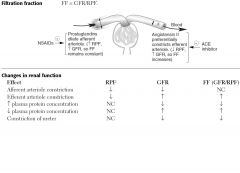
Lowers RPF
Increases glomerular capillary P Increases GFR Increases vascular resistance of renal vessels Increases filtration fraction (GFR/renal plasma flow) |
|
|
|
Sensory-neural deafness is caused by damage to 2 things…
Lose sensitivity to _ -frequency sounds |
Damage to hair cells of cochlea and/or vestibulocochlear nerve
high-frequency loss more common |
|
|
|
Serous pericarditis is caused by (2 things)
|
Viral, esp. Coxsackie (picorna, ss linear, no env, icosahedral)
Uremia RA PERICarditis: Pulsus paradoxus ECG(PericarditiS => ST elev. + precordial PR dep.) Rub Increased JVP Chest pain [worse on inspiration, better when lean forward] Pericarditis caused by CARDIAC RIND: Collagen vascular disease Aortic aneurysm Radiation Drugs (e.g. hydralazine) Infections Acute renal failure Cardiac infarction Rheumatic fever Injury Neoplasms Dressler's syndrome |
|
|
|
Severe nephrotic syn in AIDS pts
|
focal segmental glomerular sclerosis
|
|
|
|
Sheehan's syndrome
|
Post-partum anterior pituitary necrosis
RFs: hemorrhage, DIC (HELLP, amniotic fluid embolism) Hypertrophy, hyperplasia of lactotrophs during pregnancy enlarges anterior pituitray without corresponding increase in blood supply Anterior pituitary is supplied by portal venous system (low-pressure) Posterior pituitary not affected b/c of direct arterial supply |
|
|
|
Sipple's syndrome:
Disease Inheritience, genetic change Associated with… |
Men 2:
AD, ret gene Parathyroid + 2 C's Catecholamines: Pheochromocytoma Carcinoma: Medullary of thyroid |
|
|
|
Sjogran's:
3 classic findings age cancer risk |
Dry eyes
Dry mouth Arthritis 40-60 y/o increased risk of B-cell lymphoma |
|
|
|
Small % of pheochromocytomas occur in 3 familial syndromes…
|
MEN2, MEN3, von Hippel-Lindau
|
|
|
|
Smoking-associated lung cancers (3)
and how to tell them apart |
Squamous: Strong assoc. c/ smoking, "Sentral", PTH-like peptide
Small cell: central, aggressive, ACTH, ADH Large cell: peripheral, poorly-diff., adeno or sq |
|
|
|
(+) HepB sAg implies _
|
(+) HepB sAg implies =>
ongiong HBV replication Appears in blood before clinical sx Persistant HepB sAg => infectivity |
|
|
|
Sources of brain mets
|
Lung, Breast, Skin (melanoma), Kidney (renal cell), GI
"Lots of Bad Stuff Kills Glia" Well-cicumscribed tumors, @ gray-white border Mets = 50% of brain tumors |
|
|
|
Sources of liver mets
|
Colon > gastric (Stomach) > Pancreatic > Breast > Lung
"Cancer Sometimes Penetrates Benign Liver" |
|
|
|
Sphingolipidosis:
cardiomegaly angiokeratoma = red/purple skin rash kidney failure what disease? What defect? Inheritence? |
Fabry's
X-linked R Defect in alpha-galactosidase => globoside accumulation |
|
|
|
Struvite stone:
made of _, _, _ caused by _, _, _ |
Made of ammonium + Mg + P
caused by Proteus, Staph, Klebsiella Radiopaque #2 kidney stone ( staghorn calculi |
|
|
|
Nephritic syndrome
Subepithelial humps on EM |
Post-strep glomerulonephritis = diffuse proliferative nephritic syn
(SLE = sub-epithelial deposits + nephrotic syndrome) |
|
|
|
Sub-occipital lymphadenopathy
|
Rubella
Togavirus RNA, enveloped, (+)stranded Rashes: time of appearance after fever onset "Really Sick Children Must Take No Exercise": • Number of days after fever onset that a rash will appear: 1 Day: Rubella 2 Days: Scarlet fever/ Smallpox 3 Days: Chickenpox 4 Days: Measles (and see the Koplik spots one day prior to rash) 5 Days: Typhus & rickettsia (this is variable) 6 Days: Nothing 7 Days: Enteric fever (salmonella) |
|
|
|
Sulfur granules
seen as _ infection c/ _ on microscopy Organism normally found in _ Tx |
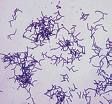
Actinomyces israelii
Oral infection c/ gram (+) branching rods Sulfur granules in sinus tracts Normal oral flora (unlike Nocardia, which is found in soil) Tx = Penicillin (Sulfa for Nocardia, "SNAP") |
|
|
|
Swollen gums, poor wound healing, brusing
Due to _, which is necessary for _ |
Scurvy
Vit C necessary for hydroxylation of proline and lysine in collagen synthesis |
|
|
|
Systolic ejection murmur - most common
|
aortic stenosis
|
|
|
|
Systolic ejection murmurs (3)
_ c/ inspiration course of murmur over cycle of a heart beat |
Aortic stenosis, Pulmonic stenosis, ASD
R side murmurs increase c/ inspiration L side decrease c/ inspiration Start after S1, crescendo to peak @ early-mid systole, close before S2 |
|
|
|
Systolic murmur transmitted to carotid. Pulsus parvus et tardus.
|
Aortic stenosis
|
|
|
|
Tabes dorsalis
pathogenesis characterisitic finding can lead to… |
Neurosyphilis = tertiary syphilis
Due to demyelination of doral columns, which carry position sense No patellar reflex = Westphal's sign Can lead to paralysis, dementia, blindness |
|
|
|
T-cell proliferative disorder of skin
Presents early as red-brown raised patches |
Mycosis fungoides
|
|
|
|
Testicular germ cell tumor
Uniform polyhedral cells Good prognosis Tumor? Tx? Population? |
Seminoma
#1 germ cell tumor (and 90% of testicular tumors are germ cell) Peaks @ age 35 Radiosensitive |
|
|
|
Testicular tumor
High beta HCG Highly malignant Gynecomastia |
Choriocarcinoma
Can occur as an element of other germ cell tumors Peaks in teens-20's |
|
|
|
Testicular tumor in elderly pt
|
Lymphoma
Spermatocytic ceminoma @ older age than seminoma, better prognosis |
|
|
|
Tetrology of Fallot consists of …
Mid-sysolic murmur @ upper L sternal border is 2/2 _ Children squat to _ sx b/c _ |
Tetrology of Fallot: PROVe
1. Pulmonary stenosis 2. R ventricular hypertrophy 3. Overriding aorta 4. VSD R ventricular outflow tract -> R to L shunt, Mid-sysolic murmur @ upper L sternal border Squatting relieves sx by increasing SVR |
|
|
|
Therapeutic index of a drug
|
toxic dose / effective dose
lower index => less drug needed to be toxic |
|
|
|
Thickening of glomerular MB + proliferation of mesangium
subENDOthelial or intra-membranous immune complex deposits |
Membranoproliferative glomerulonephritis
Nephritic syndrome Sub-ENDOthelial humps on EM Young adults Poor prognosis: slowly progresses to renal failure |
|
|
|
Thrombolytics:
mechanism drugs 2 applications tx for toxicity |
Convert plasminogen to plasmin => cleave thrombin + fibrin clots
tpA (alteplase), streptokinase, urokinase, anistreplase early MI, ischemic stroke tx for toxicity = aminmocaproic acid |
|
|
|
Thymoma is ass'd c/ paraneoplastic syndrome _
|
Myasthenic syndrome
|
|
|
|
Thyroidization of kidney
|
Chronic bacterial pyelonephritis
|
|
|
|
Top 2 causes of dementia
|
1. Alzheimer's
2. Multi-infarct |
|
|
|
Top 3 coronary arteries involved in thrombosis:
|
1. LAD => anterior LV wall, anterior 2/3 of septum, anterior papillary muscle
2. RCA => inferior LV (posterior descending), RV wall (acute marginal) 3. LCA --> LAD, CFX (lateral + posterior superior LV) |
|
|
|
Top causes of SIADH
complications therapy |
SIADH: euvolemic hyponatremia
urine Na >20 mEq/L (i.e. NOT hypovolemic) urine osmolality >50-100 mOsm/Kg Head injury, tumor Sarcoid, pneumonia Small cell lung ca Post-op status Chlorpropamide, oxytocin, cyclophosphamide, morphine, sulfonylurea Tx: #1 = Fluid restriction Demelocycline = ADH antagonist |
|
|
|
tPA is secreted by _ cells
works under what conditions? |
tPA is secreted by endothelial cells.
optimized by binding to fibrin activity is restricted to site of clot activates plasmin to degrade fibrin |
|
|
|
neuro changes: delirium, seizure, stroke
low platelet count microangiopathic hemolytic anemia impaired renal fx fever Dz Tx |
TTP:
neuro changes: delirium, seizure, stroke low platelet count microangiopathic hemolytic anemia impaired renal fx fever high bleeding time, indirect bili, LDH, AST Low haptoglobin Normal coag factors Tx: steroids to decrease microthrombus formation Plasma replacement, plasmapheresis NO platelet transfusions (NOTE: severely high Cr => HUS. Pregnancy => HELLP. high PT, aPTT => DIC) |
|
|
|
Tx for addisonian crisis
|
4 S's of adrenal crisis mgmt:
Salt: 0.9% saline Steroids: IV hydrocortisone 100 mg q8h Support Search for underlying illness: Addisons = adrenal dz, polyglandular autoimmune syndrome, congenital enzyme deficiency, adrenal hemorrhage, TB, pituitary (may be 2/2 to stopping long-term steroids) |
|
|
|
Thirst, polyuria, inability to concentrate urine
What disease? Tx? |
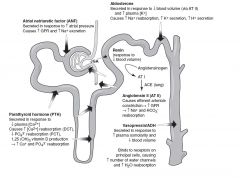
Diabetes inspidus
Central: Vasopressin/ Desmopressin = ADH analog Nephrogenic (due to lithium, demeclocycine, hypercalemia): HCTZ, indomethacin, amiloride |
|
|
|
Type 2a hypercholesterolemia
|
LDL R defect
|
|
|
|
Type 4 renal tubular acidosis:
Due to _ or _ Anion gap? Electrolyte change_ |
Aldosterone deficiency or tubular resistance to aldosterone
Mild metabolic acidosois s/ anion gap High K+ |
|
|
|
Type of ovarian cyst ass'd c/ hyperestrinism, endometrial hyperplasia
|
Follicular cysts
|
|
|
|
Sq cell carcinoma, esp in sun-exposed area
|

Ulcerated, red lesion on an old person
|
|
|
|
Uric acid kidney stone:
Seen in 2 diseases |
Gout, myeloproliferative disorders
Radiolucent |
|
|
|
V/Q is highest @ _ in area of lung, lowest @ _
|
High+C670est @ top, lowest @ bottom
|
|
|
|
Humeral shaft fracture injures the _ nerve,
which causes motor symptom of _ or pt unable to _ th arm |
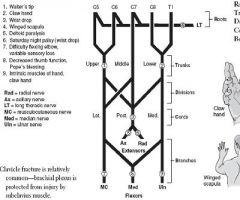
Radial -> WRIST DROP, unable to supinate
Innervates the BEST: brachioradialis extensors supinator triceps |
|
|
|
Urine osmolality >500
Urine Na <10 FeNa <1% BUN/Cr >20 What is wrong with the patient? What changes to: Renal blood flow GFR |
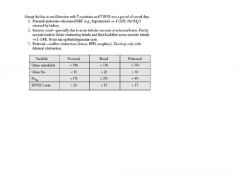
Pre-renal failure
FeNa = Na(U)/Na(P) / Cr(U)/Cr(P) |
|
|
|
asymptomatic pt c/:
diet high in salt and nitrates, low in vegetables hx gastritis enlarged L supraclavicular node |
INTESTINAL type gastric adenocarcinoma
(diffuse type NOT related to H. pylori or gastritis) Virchow's node = enlarged L supraclavicular node 2/2 metastatic stomach cancer Usually discovered incidentally Poor prognosis: <10% Tx depends on surgical excision of tumor |
|
|
|
von Hipple Lindau:
Mutation of _ -type gene on chromosome _ Inheritence Triad |
Mutation of VHL tumor supressor gene on chromosome 3
AD 1. CNS/retina hemangioblastomas (esp. in kids - cerebellar) 2. RCC 3. Cysts in internal organs HIPPEL: Hemanigoblastomas Increased renal cancer Pheochromocytoma Port-wine stains Eye dysfunction Liver, pancreas, kidney cysts |
|
|
|
von Recklinghausen
gene location 3 major sx 4 other common findings |
Neurfibromatosis type 2
Long arm of chromosome 17 (17 letters in von Recklinghausen) Café au lait spots, neural tumors, lisch nodeules = pigmented hamartomas of iris Skeletal disorders (e.g. scoliosis), optic pathway gliomas, pheochromocytoma, increased tumor risk |
|
|
|
von Recklinghausen
mutation in _ (_-type gene) on chromosome _ Inheritence Triad Increased risk of 2 things… |
Mutation in NF1 tumor-supressor gene on chromosome 17
AD 1.Café au lait spots 2. Lisch nodules (pigmented iris hamartomas) 3. Multiple neurofibromas Risk of meningiomas, pheochromocytoma 90% of NF cases CAFE SPOT: Cafe-au-lait spots Axillary, inguinal freckling Fibroma Eye: lisch nodules Seventeen (chromosome 17), Skeletal (bowing leg, etc) Positive family history Optic Tumor (glioma) |
|
|
|
pt has anemia
Bone marrow: giant neutrophils, hypersegmented mature granulocytes Elevated MMA, homocysteine subacute combined degeneration of spinal cord (see hint) |
B12 deficinecy
|
if it were folate deficinecy, would have normal MMA, elevated homocysteine
|
|
|
Wallenberg's syndrome
|
PICA thrombosis
|
|
|
|
Pt c/ altered consiousness, headache, fever
CSF: (+) for RBCs, protein Contrast-enhancing temoral lobe lesion on MRI |
HSV encephalitis
high morbidity PCR very sensitive, specific Tx: immediately start a full course of IV acyclovir |
|
|
|
Wax in ear or impaired movement of ossicles causes _-type hearing loss
Frequencies affected |
Conduction deafness => all frequencies affected
|
|
|
|
Waxy casts
|
Chronic end-stage renal disease
|
|
|
|
Pt c/:
kidney stones + stomach ulcers Family hx: ZE syndrome, insulinoma, VIPoma Prolactinoma Parathyroid hyperplasia |
Wermer's syndrome = MEN 1:
Parathyroid Pancreatic islet cell tumor: insulinoma, ZE, VIPoma Pituitary adenoma: prolactinoma Presents c/ kidney stones + stomach ulcers |
|
|
|
What deficiency?
Epithelial metaplasia, esp to eyes Conjunctival dryness => keratomalacia, corneal erosion |
Vitamin A
|
|
|
|
What vitamin? What rxns does it do?
Deficiency => Peripheral neuropathy, convulsions, hyperirritability. Seborrheic dermatitis, chelosis, glossitis |

Pyridoxine = b6
also peripheral neuropathy, seizures Converted to pyridoxal phosphate => Transamination (ALT, AST) Decarboxylation Heme synthesis |
|
|
|
What deletion?
Malignant urinary tract tumors 2/3 diagnosed by age 4 Tx = surgery |
Wilms tumor
deletion of 11p13 |
|
|
|
Brown sequard:
damage to _ tract -> loss of _-type sensation on _-lateral side, @ level _ |
spinothalamic tract injury -> loss of contralateral pain/temp sensation @ 2 levels below lesion
|
|
|
|
What disease?
HLA A3 Cirrhosis DM Heart failure Skin pigmentation RF for 2 other diseases… |
Hemochromatosis
Risk of chronic pancreatitis, pancreatic carcinoma (A team has 3 members; Mr. T wears iron medallion) |
|
|
|
What disease in newborn?
Microcephaly Nail hypoplasia (see hint) |
Fetal hydantoin syndrome
Due to phenytoin |
mom has history of tonic-clonic seizures
|
|
|
What disease? Congenital cardiac defect, inc. heart/lung fistulas
Microcephaly Short upturned nose, long philtrum Limb dislocation Mechanism may be inhibition of cell migration |
Fetal alcohol syndrome
Highest risk @ weeks 3-8 VSD>ASD |
|
|
|
What does PGI2 do?
|
pgI2 Inhibits aggregation
(txA2 Aggregates platelets) |
|
|
|
What dz?
HLA DR5 or B5 Anti-microsomal Ab's F>M |
Hashimoto's thyroiditis
Histo: atropic follicles with decreased colloid; lymphocyes, plasma cells, macrophages Pt has enlarged thyroid +/- hx of thyrotoxicity Hypothyroid later in dz |
|
|
|
What dz?
Irritability, increased GI motility, tachycardia, wt loss, muscle wasting |
Thyrotoxicosis
|
|
|
|
What vitamin deficiency decreases fertility?
|
B12
|
|
|
|
Tropheryma whipplei
Malabsorbtion > neuro change's, arthritis 90% male Tx =1 yr abx (pen, amp, tetracycline; sulfonamide for neuro sx) WHIPPLES: Weight loss Hyperpigmentation of skin Infection with tropheryma whippelii PAS positive granules in macrophage Polyarthritis Lymphadenopathy Enteric involvement Steatorrhea |
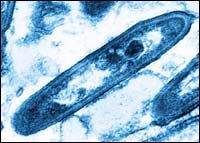
Whipple's dz:
Etiology Presentation Tx |
|
|
|
Wilson's
Inheritence Pathogenesis Tx |
Hepatolenticular degeneration
AR Cu accumulation, can't enter circulation as ceruloplasmin "ABCD": Asterixis Basal ganglia degen Corneal deposits (Kayser-Fleischer), Choreiform mvmt, Carcinoma of liver Dementia Tx = penicillamine |
|
|
|
Xerostomia + Arthritis + Keratoconjunctivitis sicca
|
Sjogren's
|
|
|
|
Young adult c/ insidious onset of glomerular BM thickening, subEPIthelial immune complex deposition:
disease IM, EM findings |
Membranous gomerulonephritis
IF: granular pattern EM: "spike + dome" |
|
|
|
Young female c/ mid-systolic click.
This murmur is also common in dz _ |
Mitral valve prolapse
Marfan's |
|
|
|
Zollinger-Ellison:
definition associated with 3 things |
Gastrin-secreting tumor of pancreas or duodenum.
Ass'd c/ recurrent ulcers, hyercalcemia, MEN1 |
|
|
|
Brain mets - 2 primaries…
|
Lung > Breast
|
|
|
|
Bone mets - 2 primaries …
|
Breast > Lung
|
|
|
|
Liver mets - 3 primaries …
|
Colon > Stomach > Pancreas
|
|
|
|
Tx for ventricular tachycardia (4 possible)
|
Be a PAL!
BETA BLOCKER PROCAINAMIDe = class 1a = prolongs purkinje repolarization PROCAINAMIDe = class 1a = prolongs purkinje repolarization LIDOCAINE = class 1b = shortens purkinje repolarization |
|
|
|
high alpha fetoprotein in pregnancy ...
|
"Increased Maternal Serum Alpha Feto Protein":
Intestinal obstruction Multiple gestation/ Miscalculation of gestational age/ Myeloschisis Spina bifida cystica Anencephaly/ Abdominal wall defect Fetal death Placental abruption |
|
|
|
What type of hypersensitivity?
Ab + complement lead to membrane attack complex => lysis or phagocytosis |
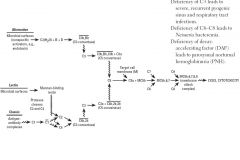
Type 2 = IgG, IgM -mediated = "Cy-2-toxic"
|
|

